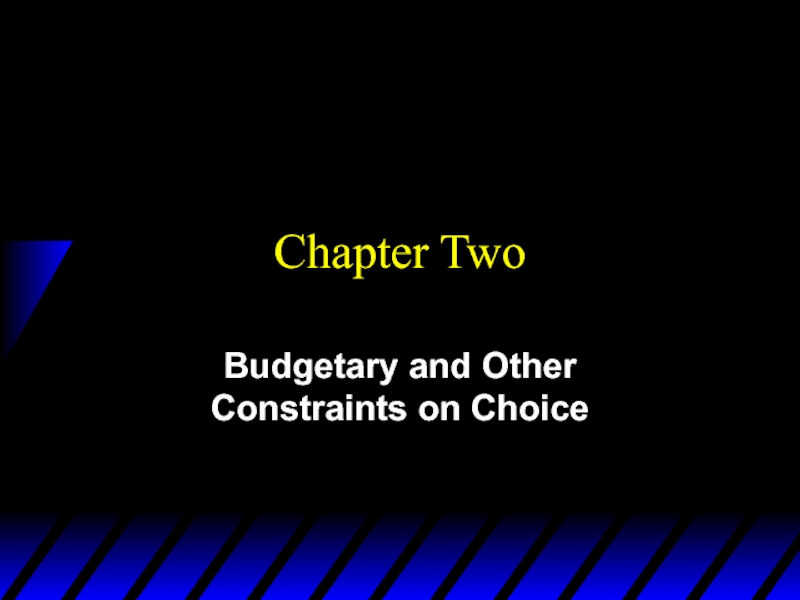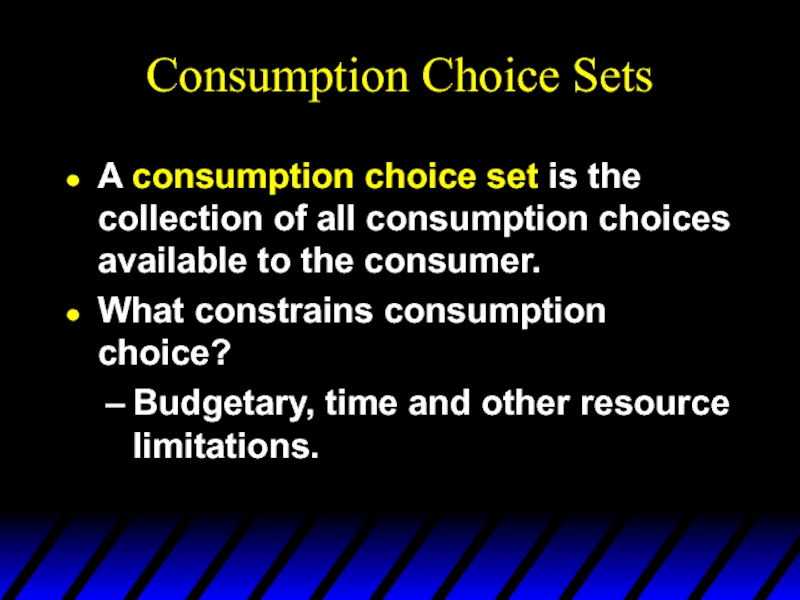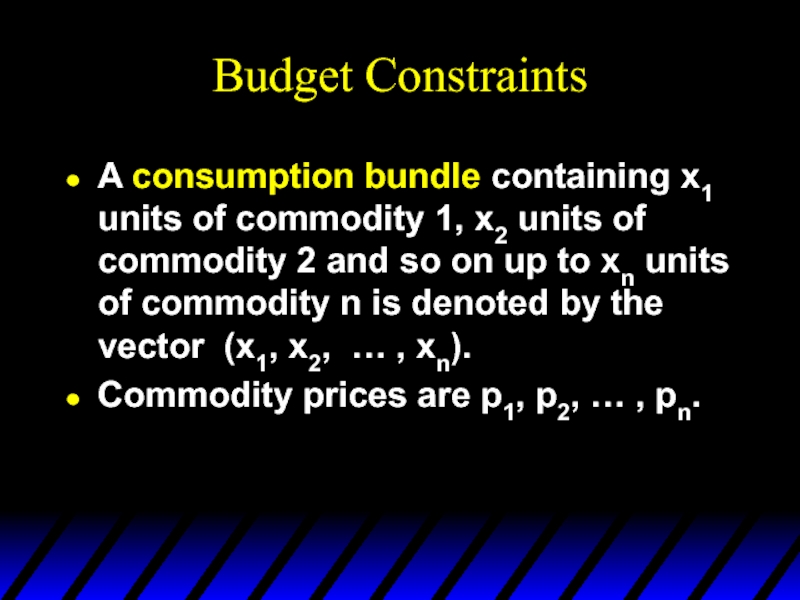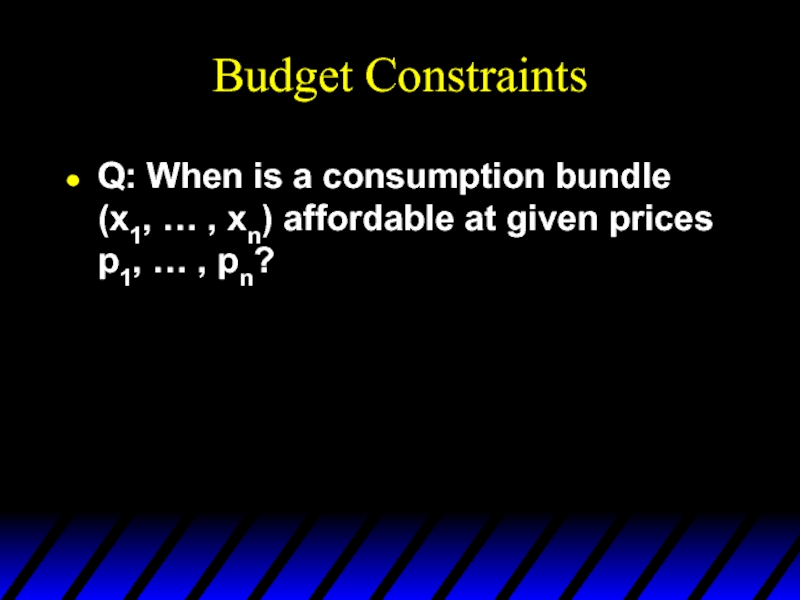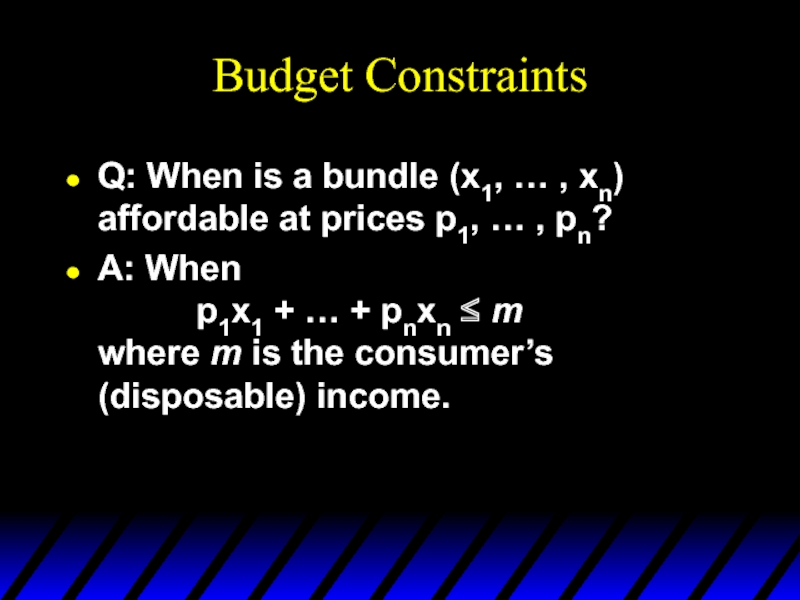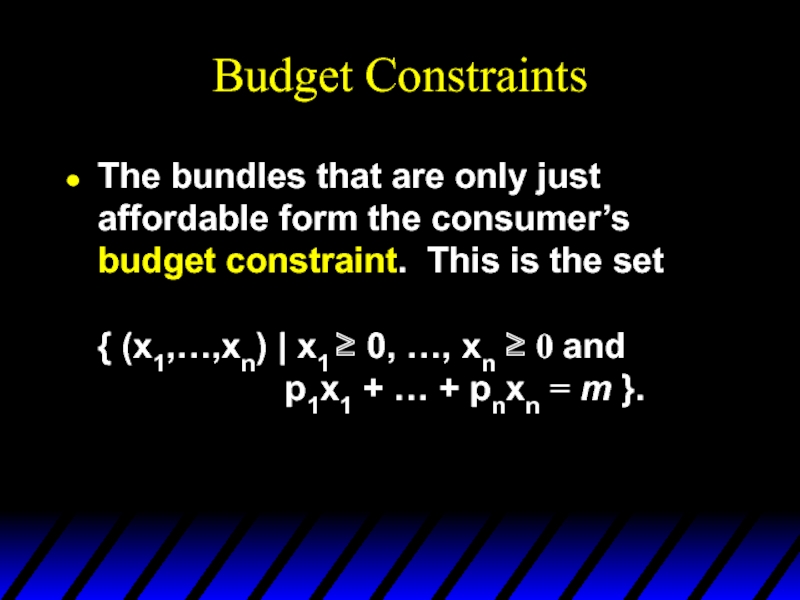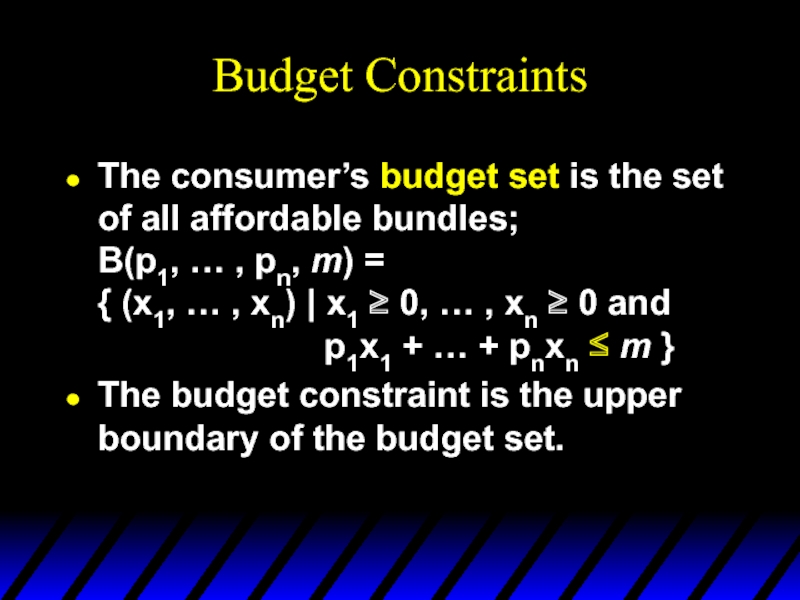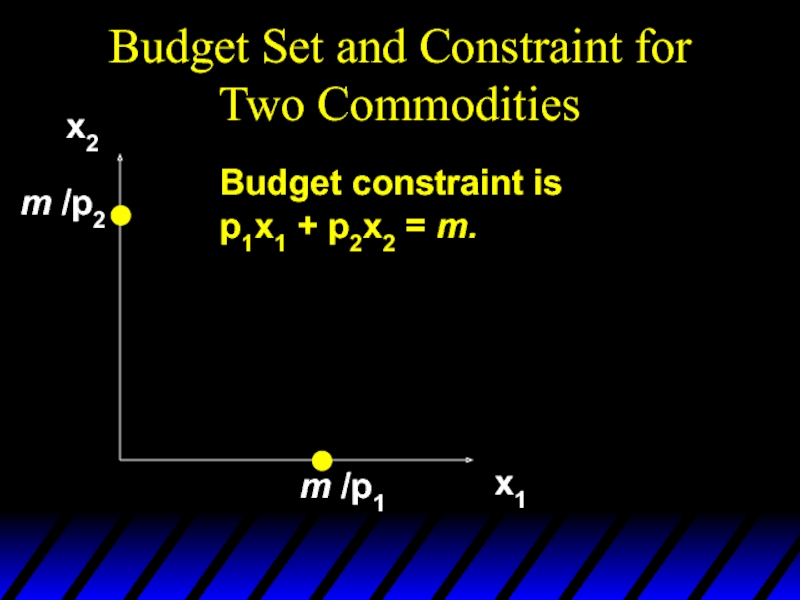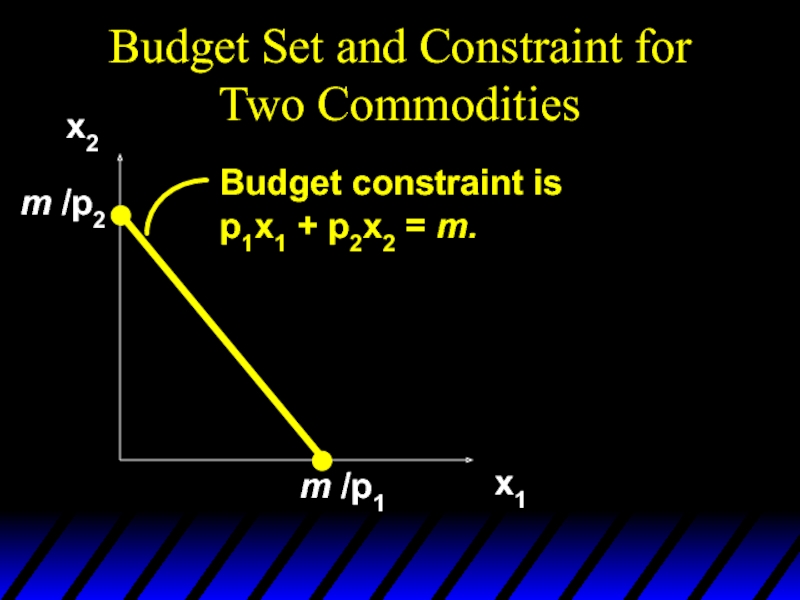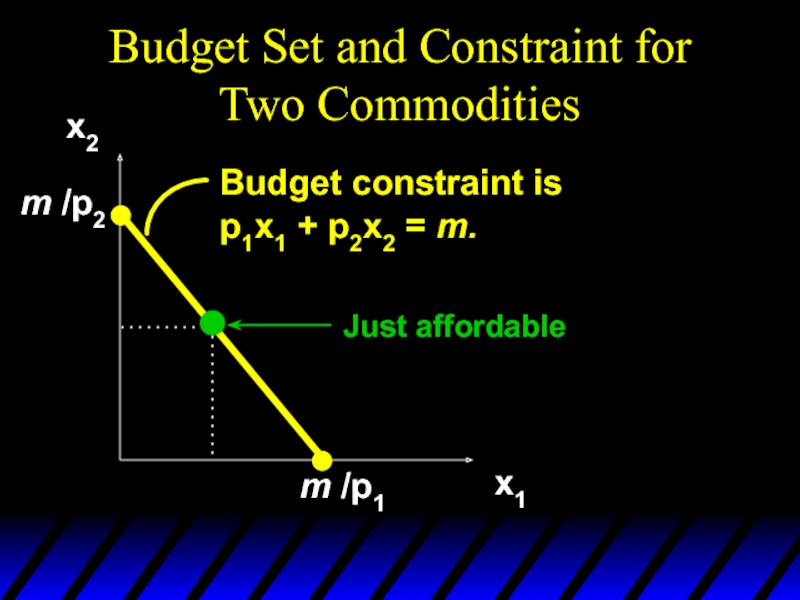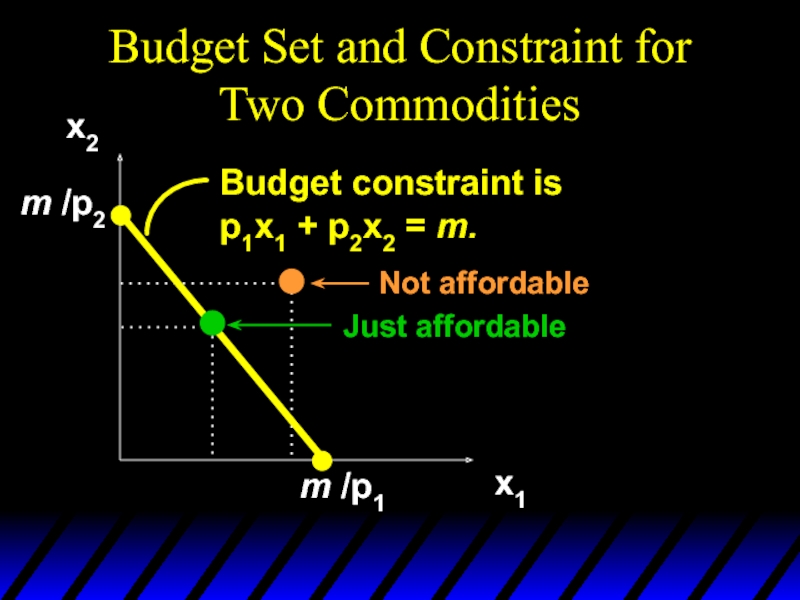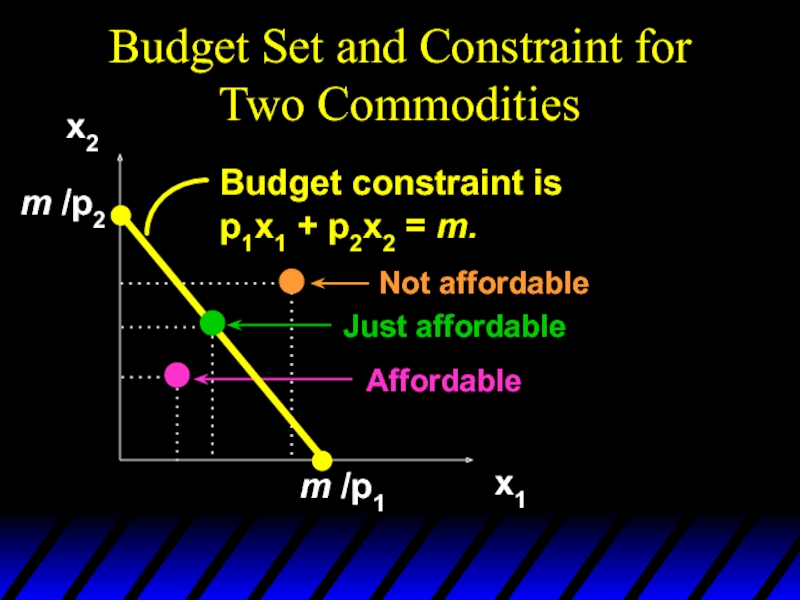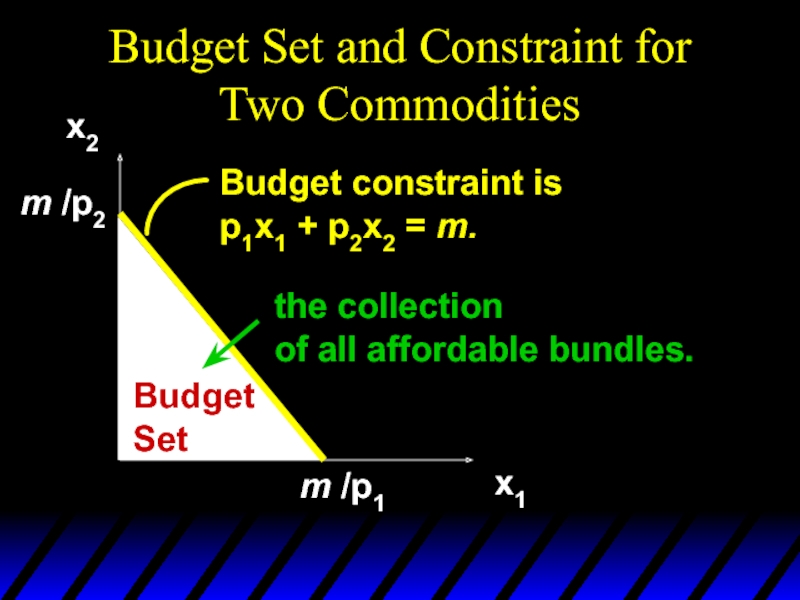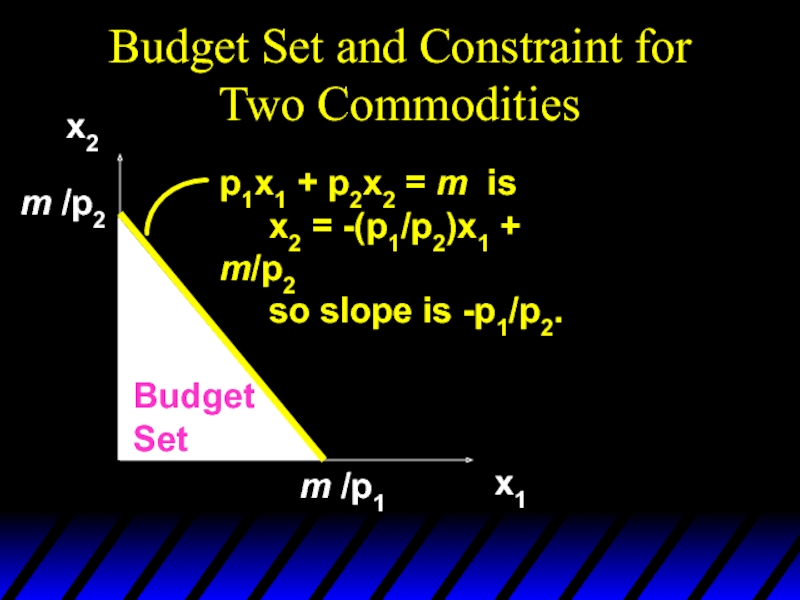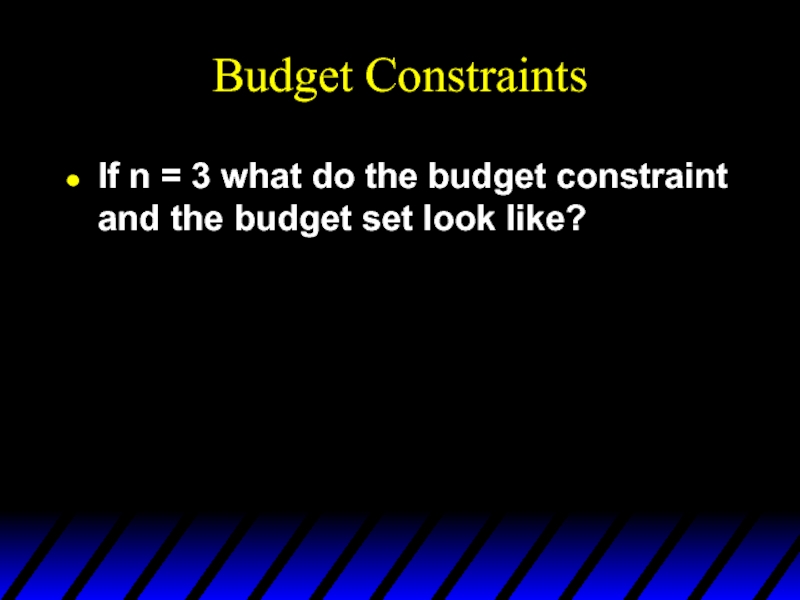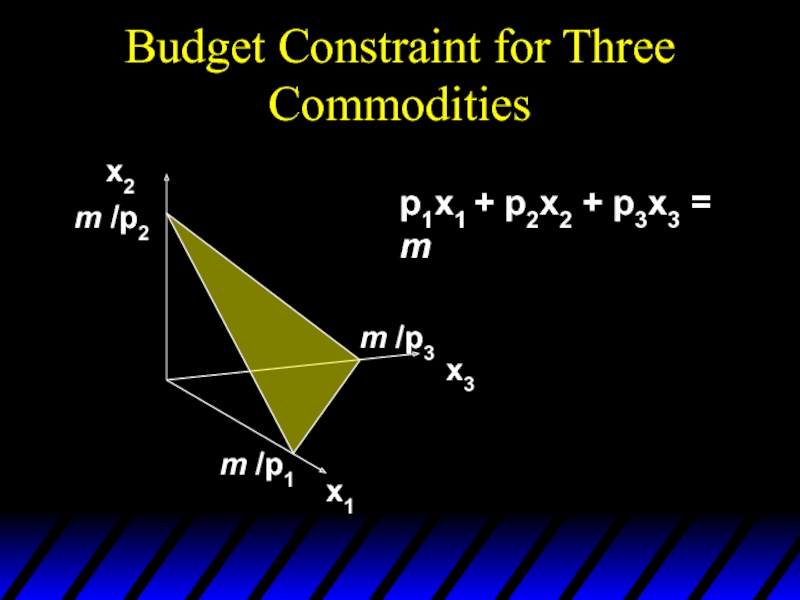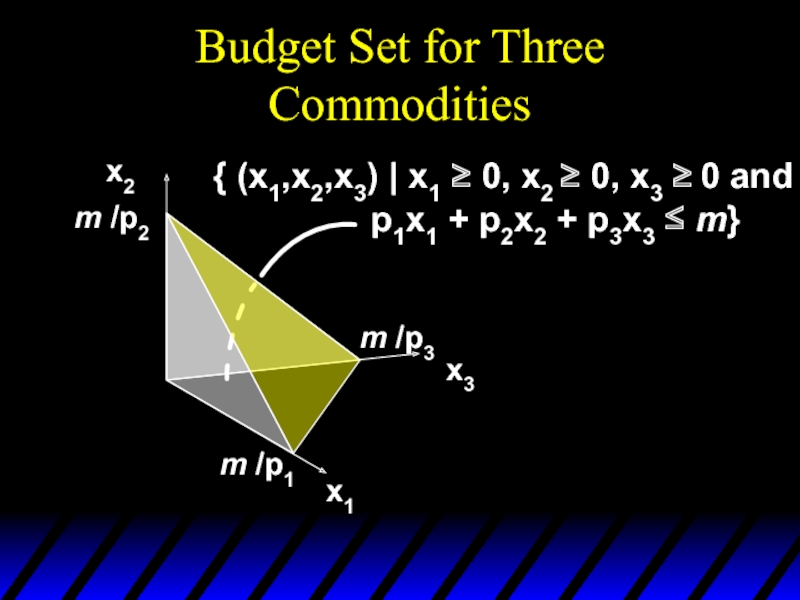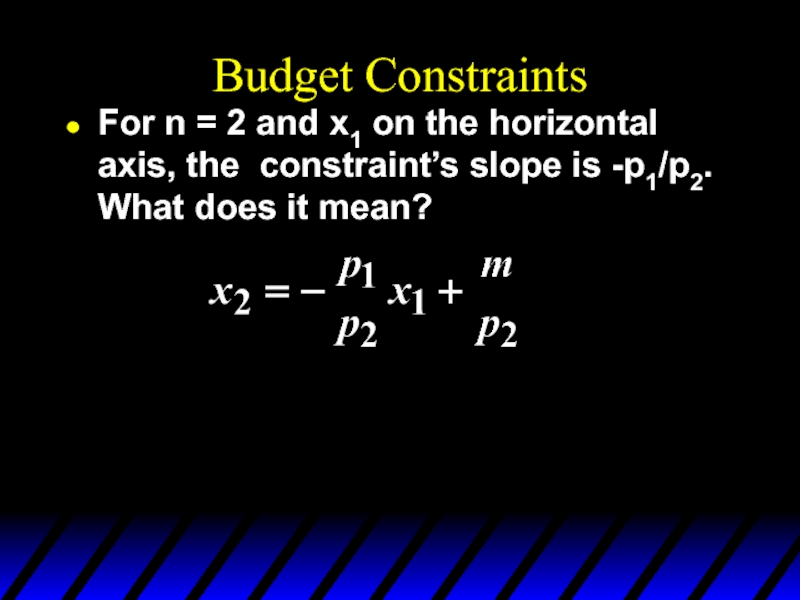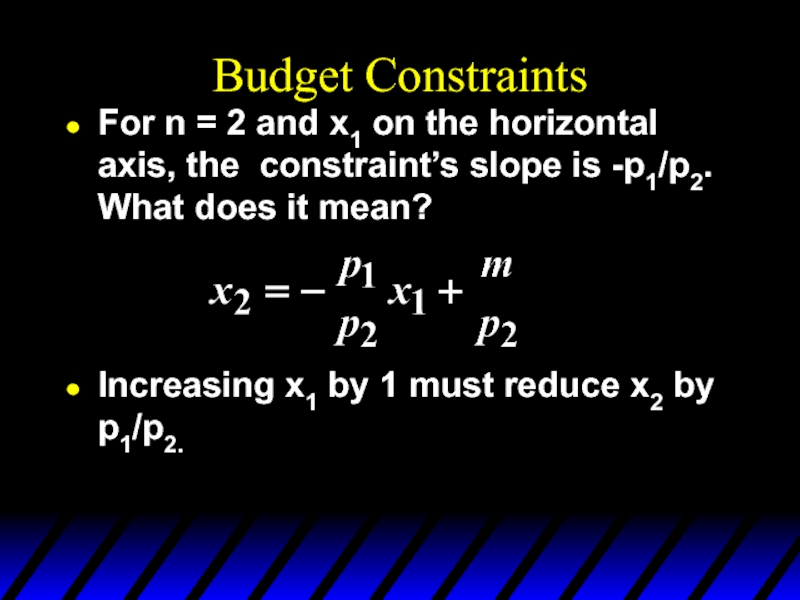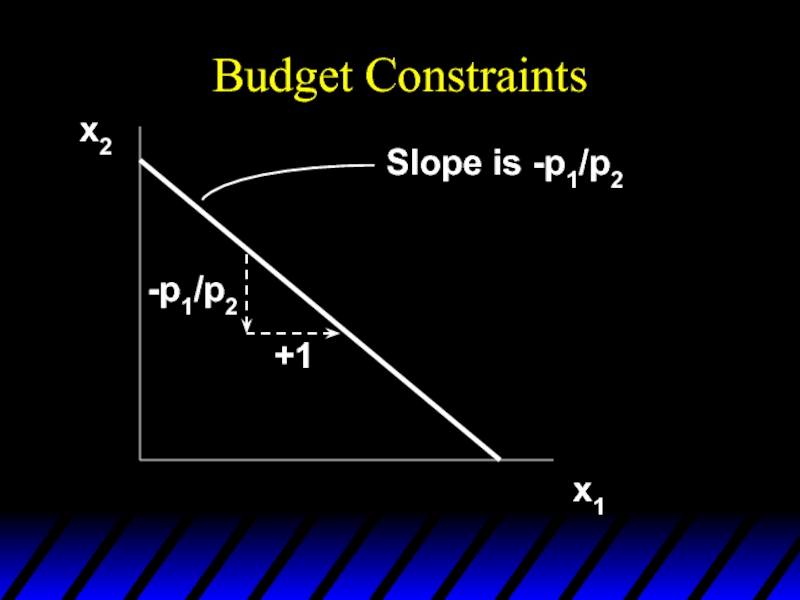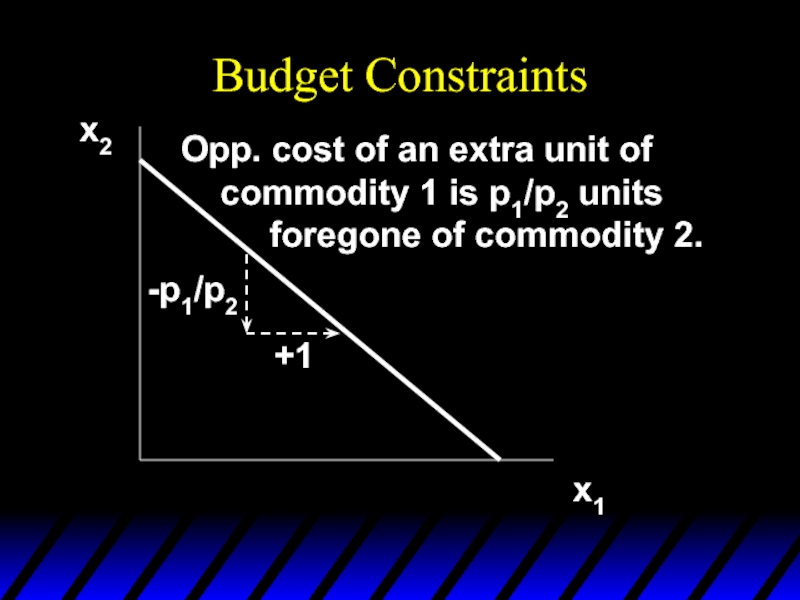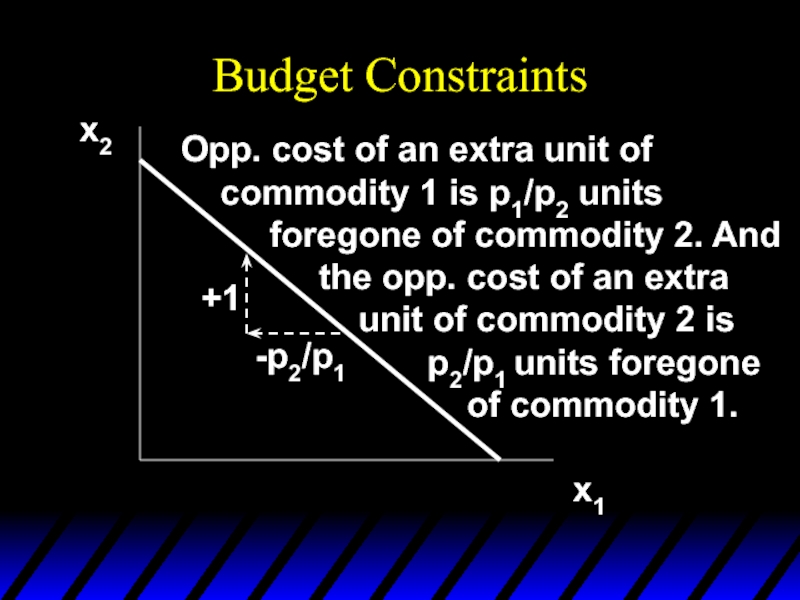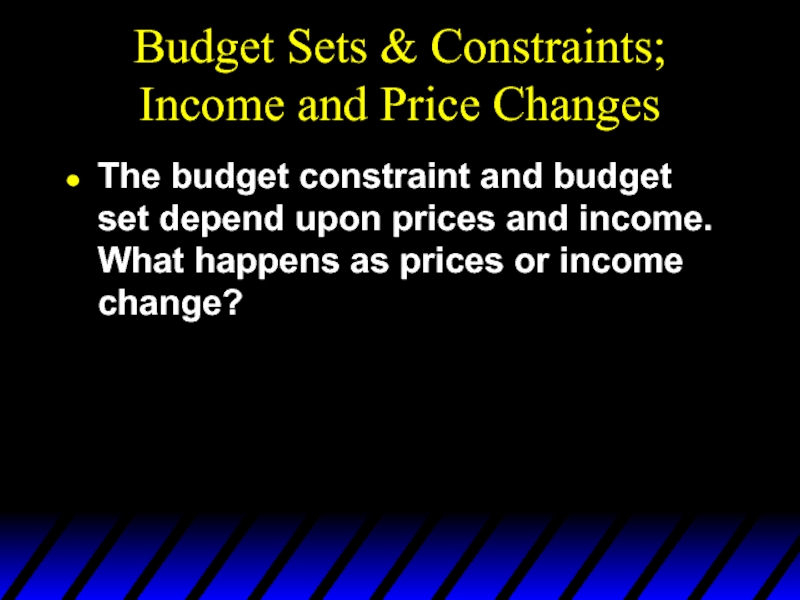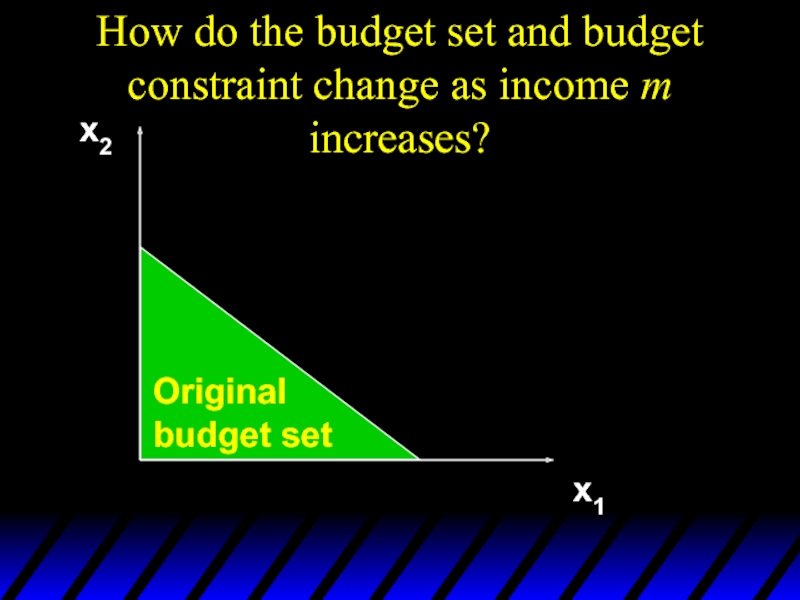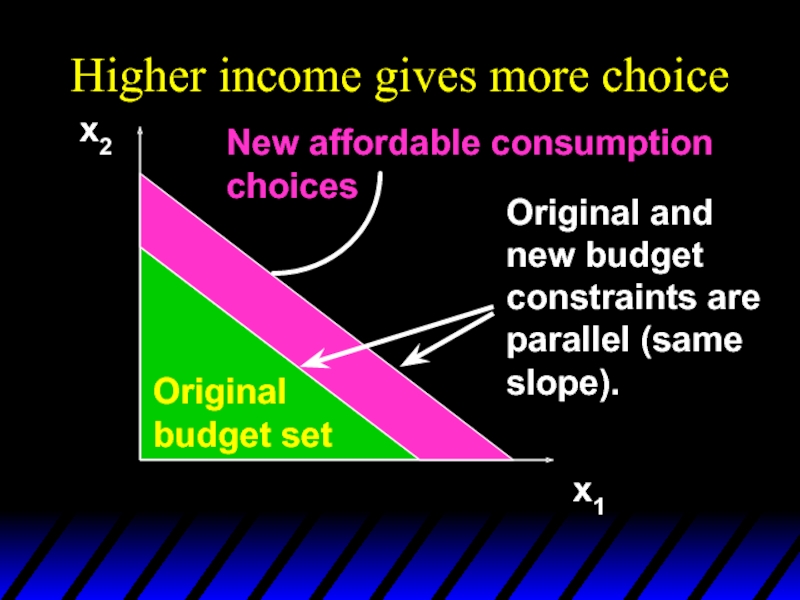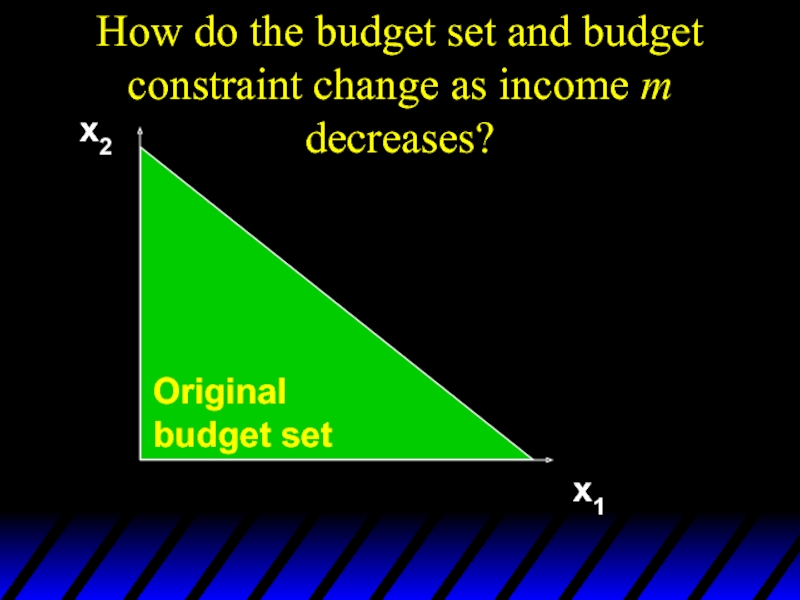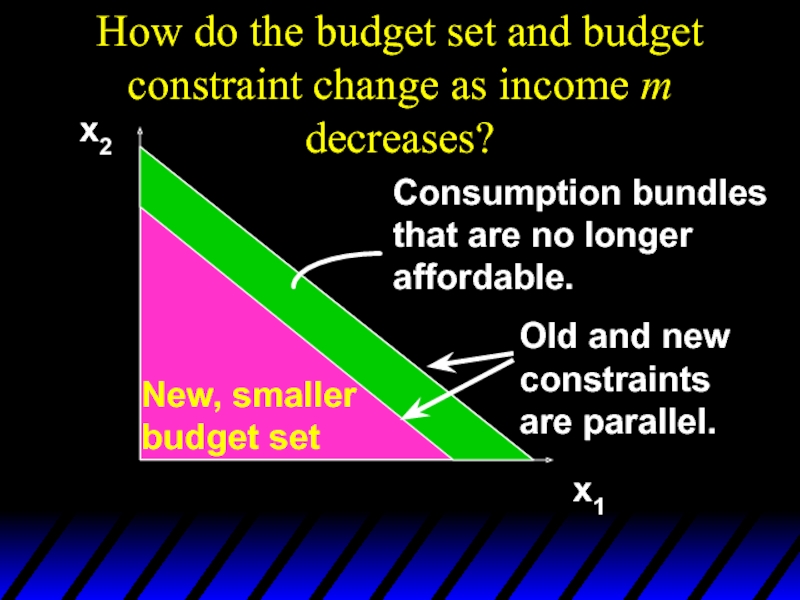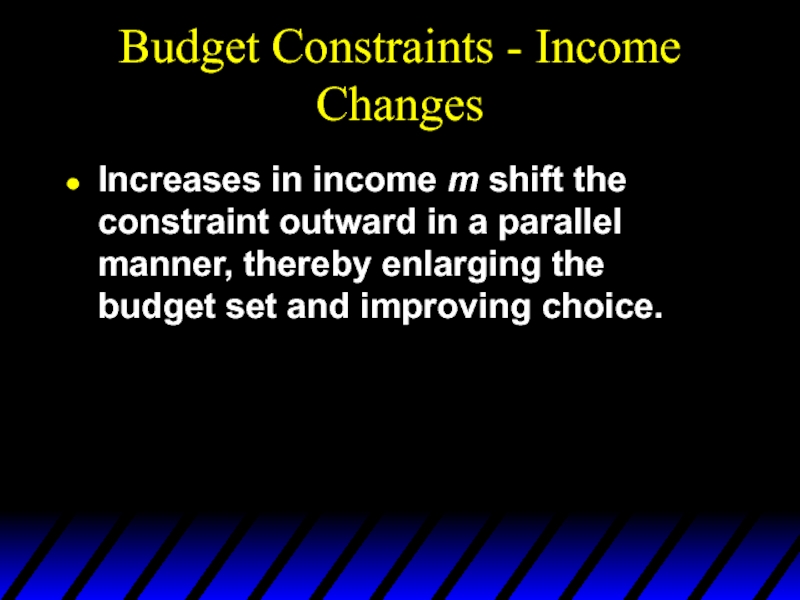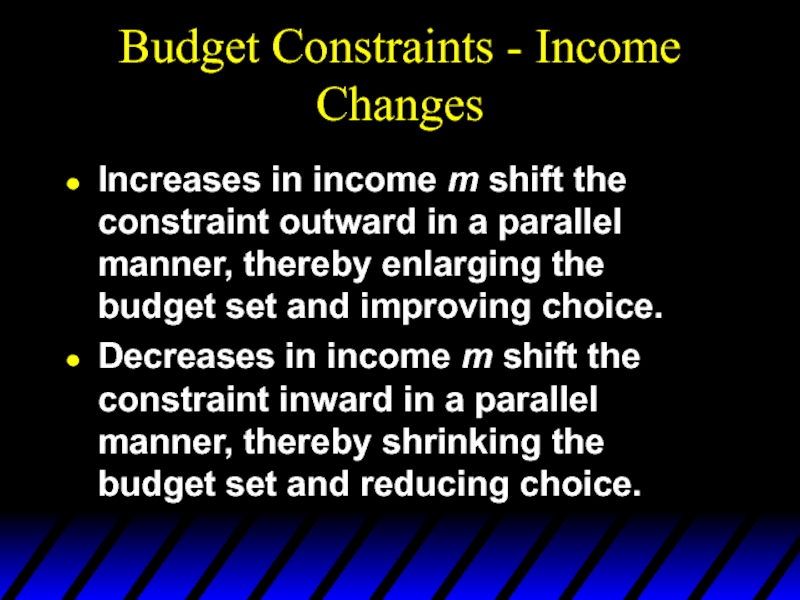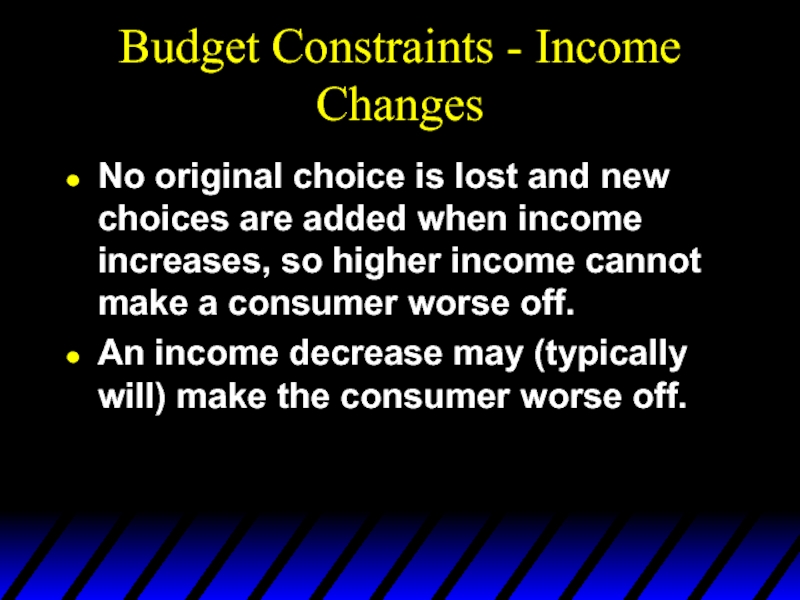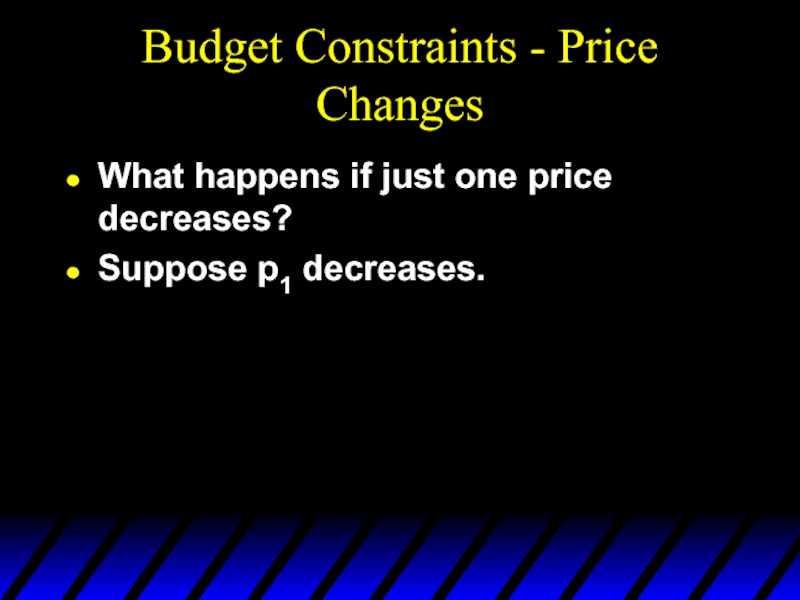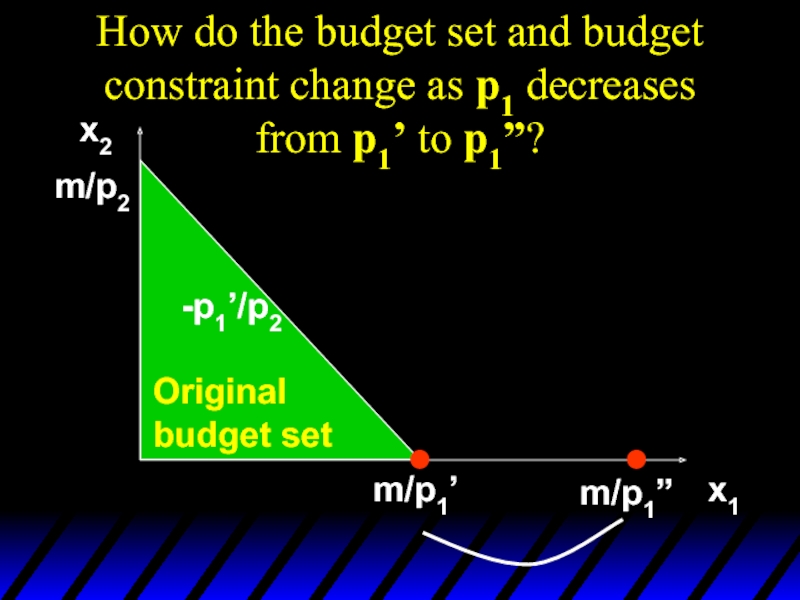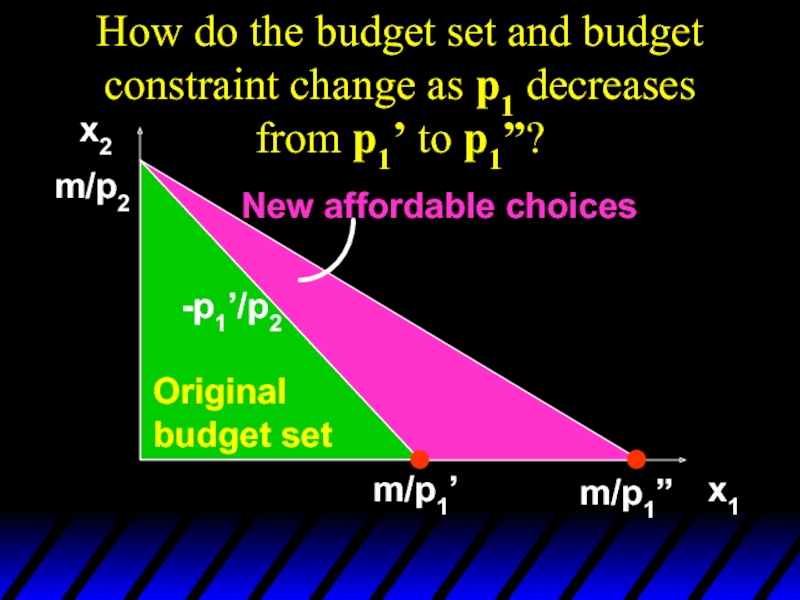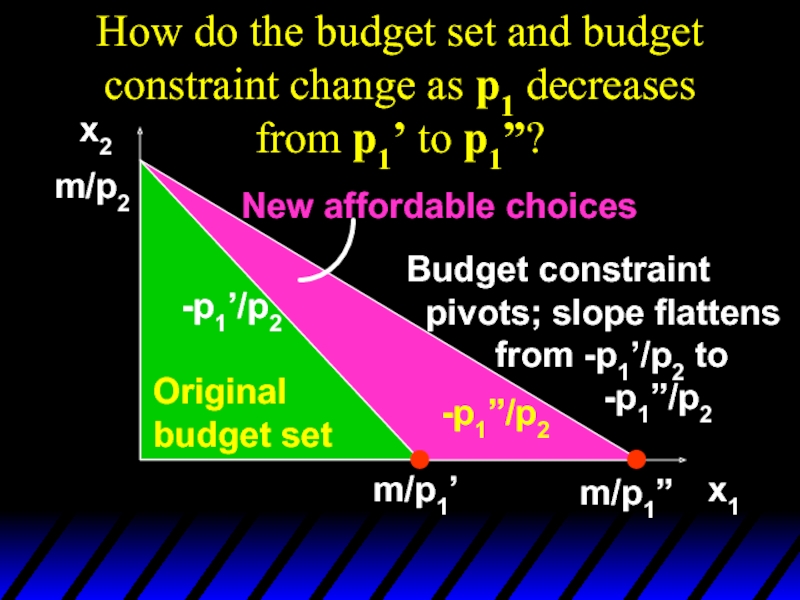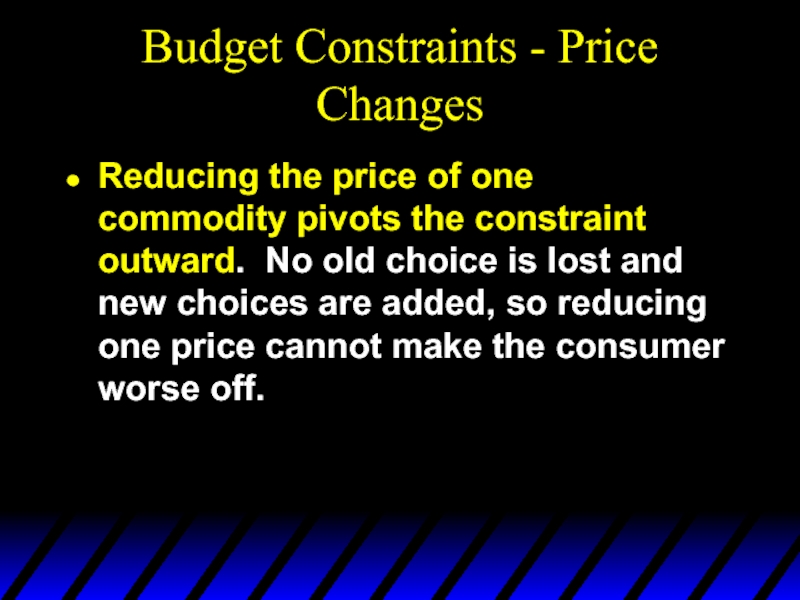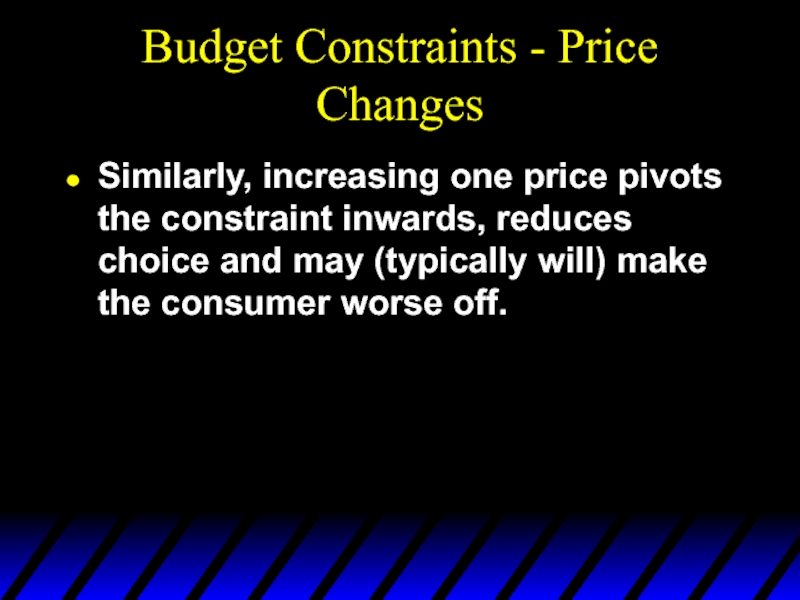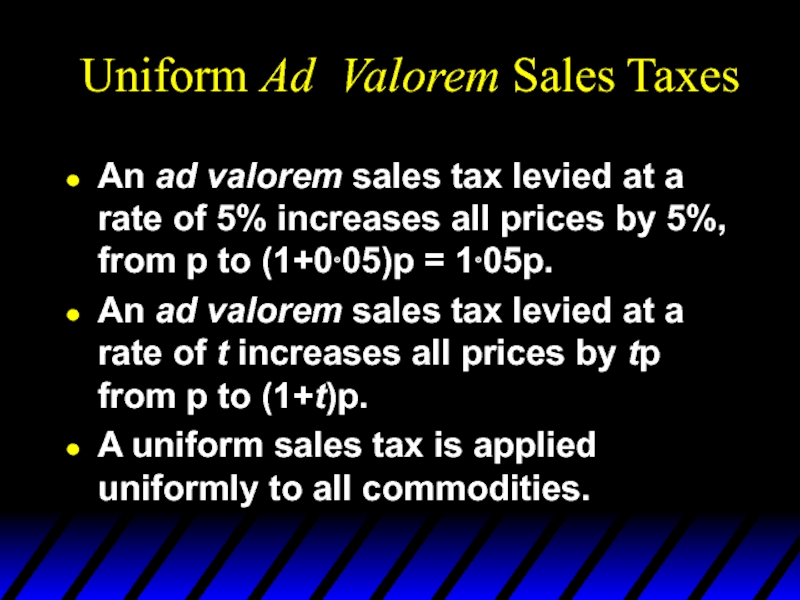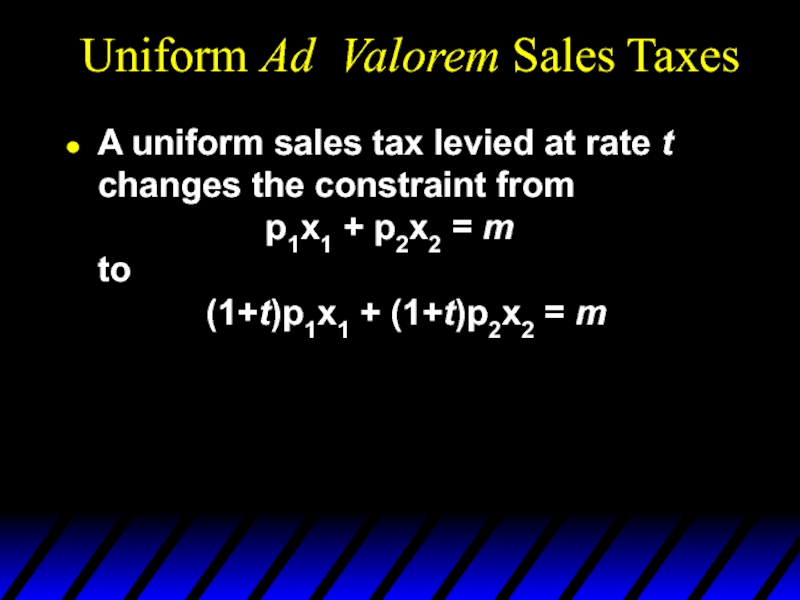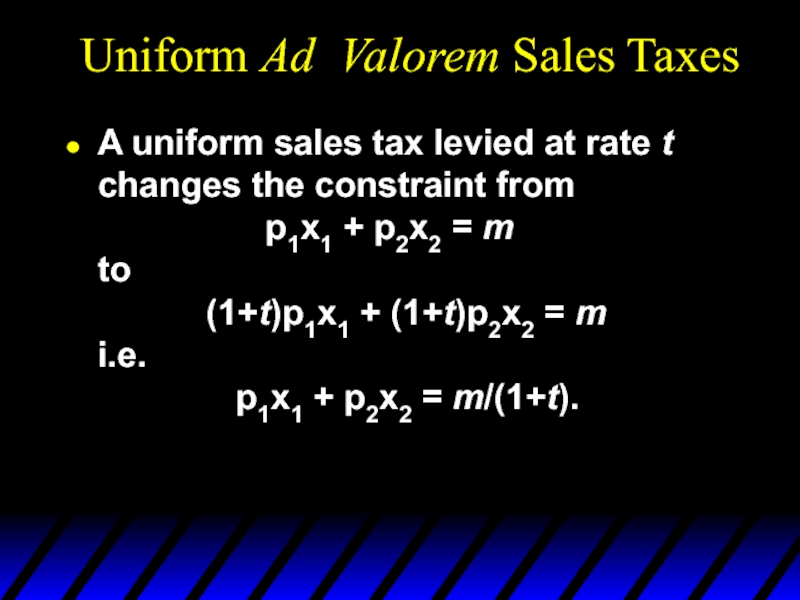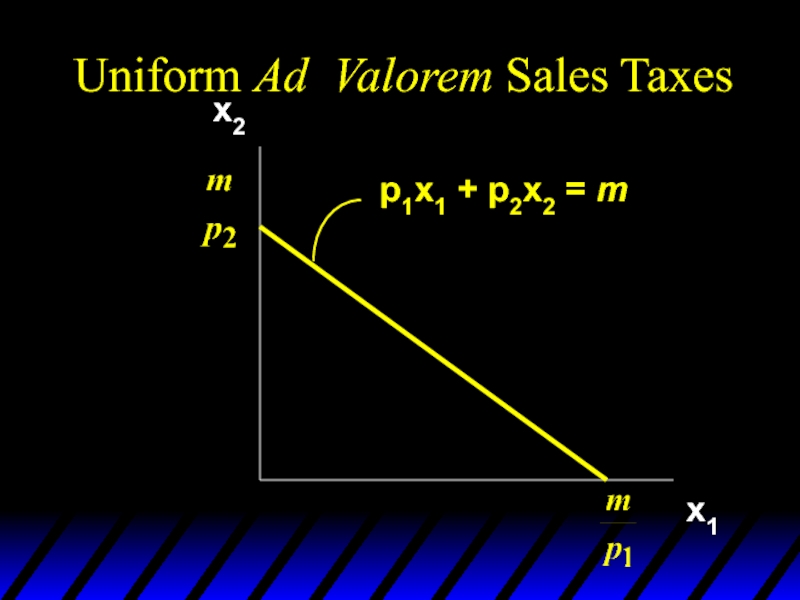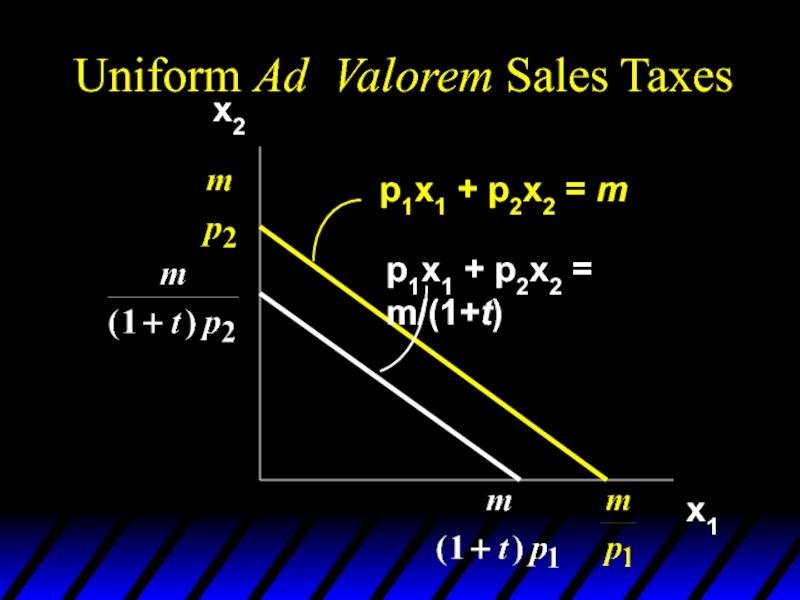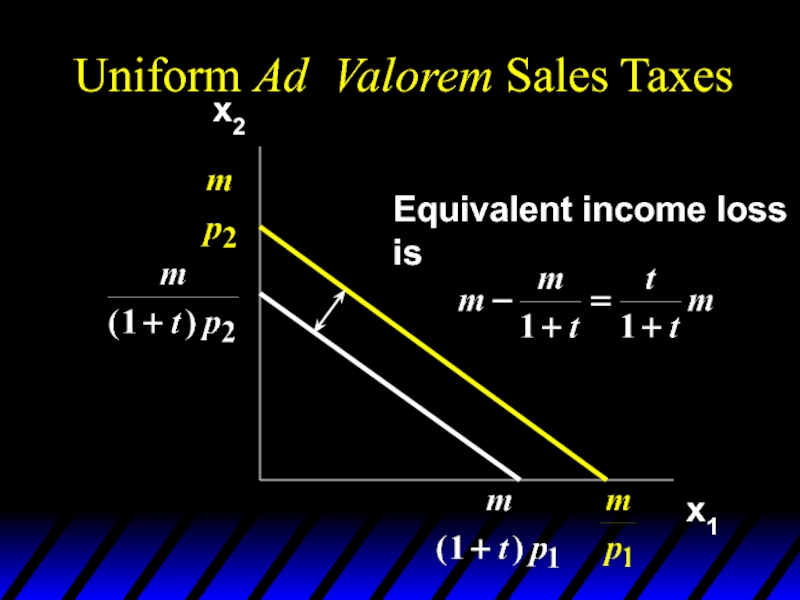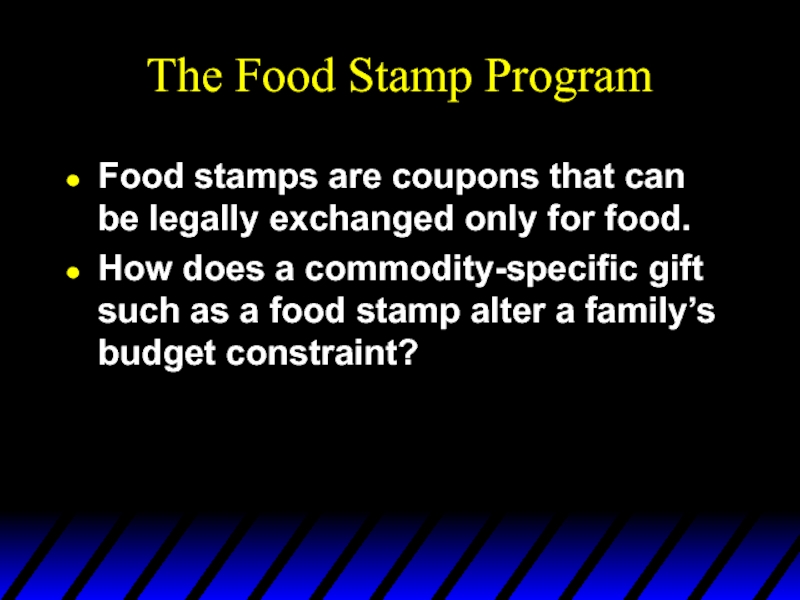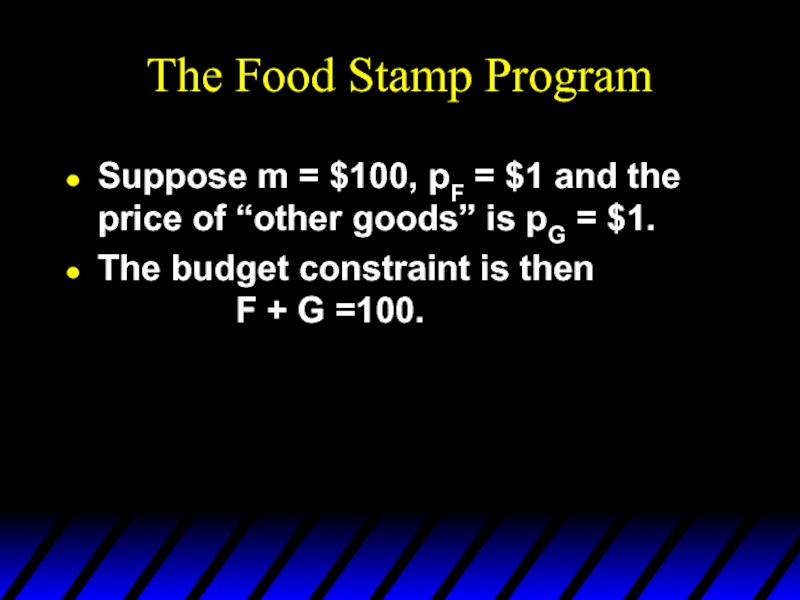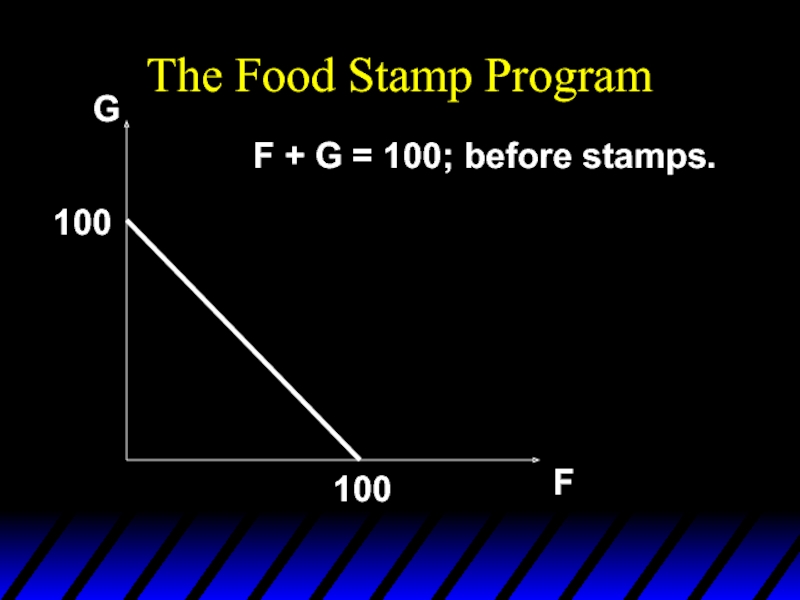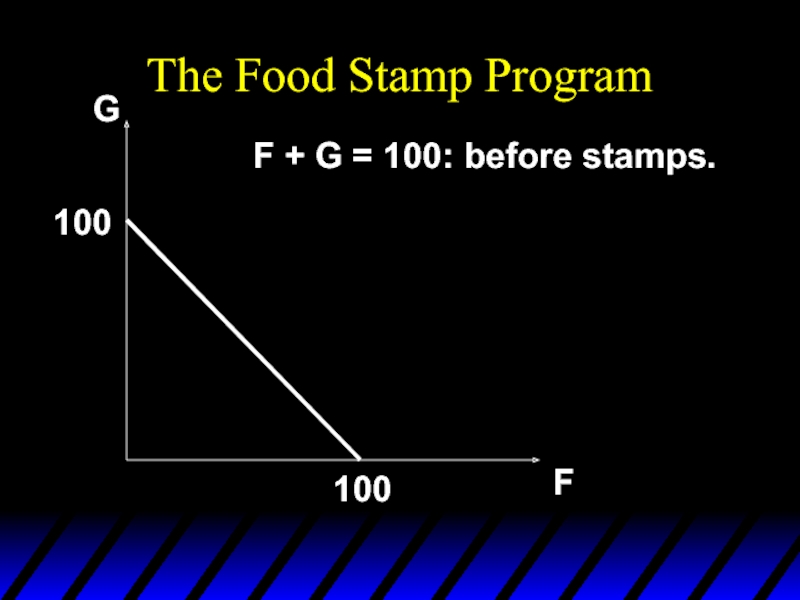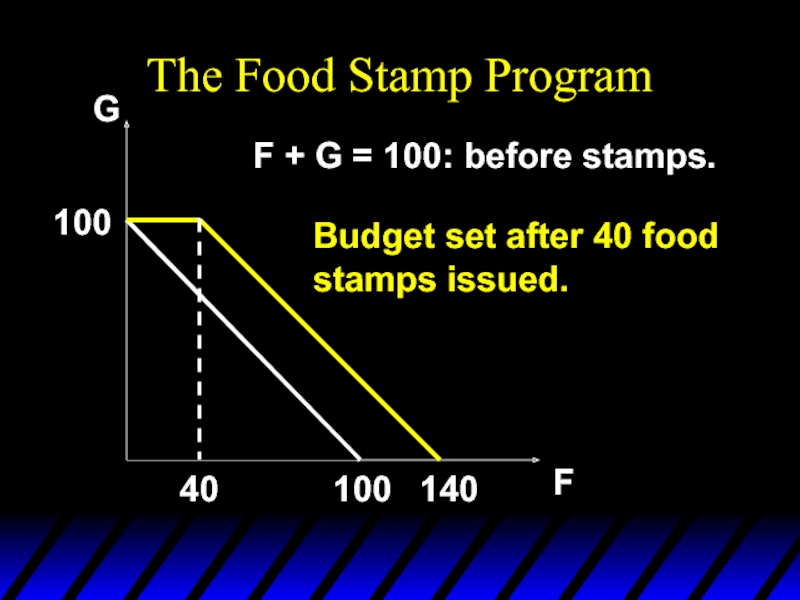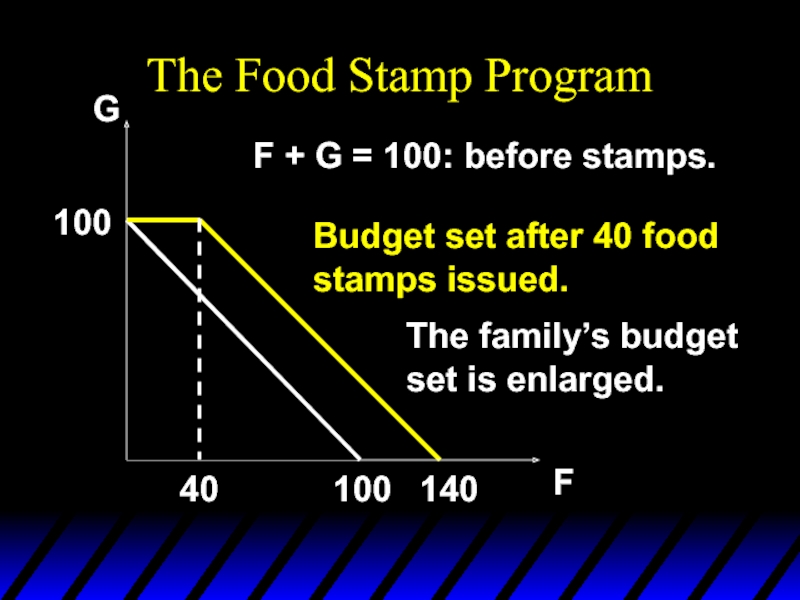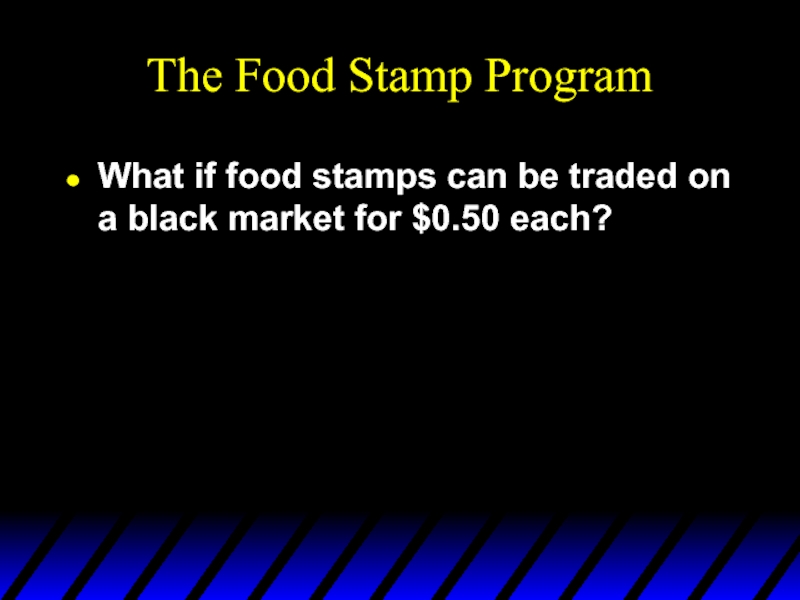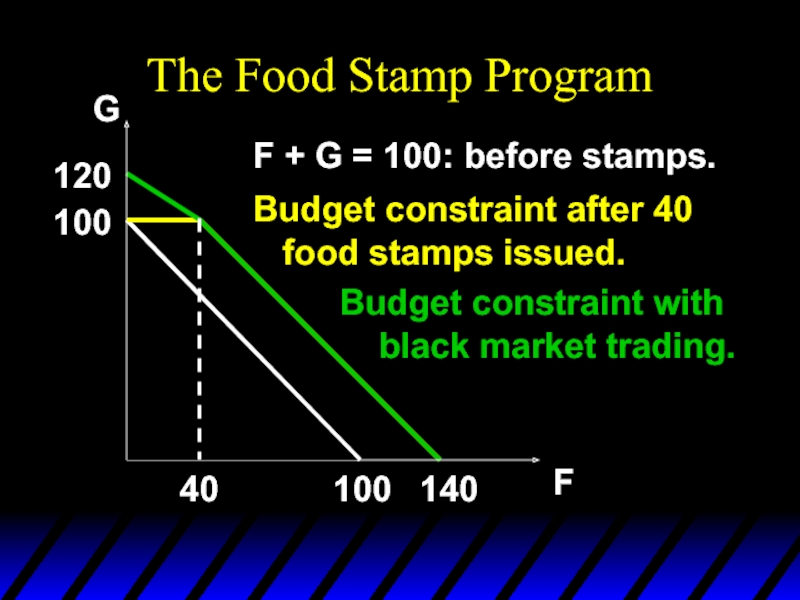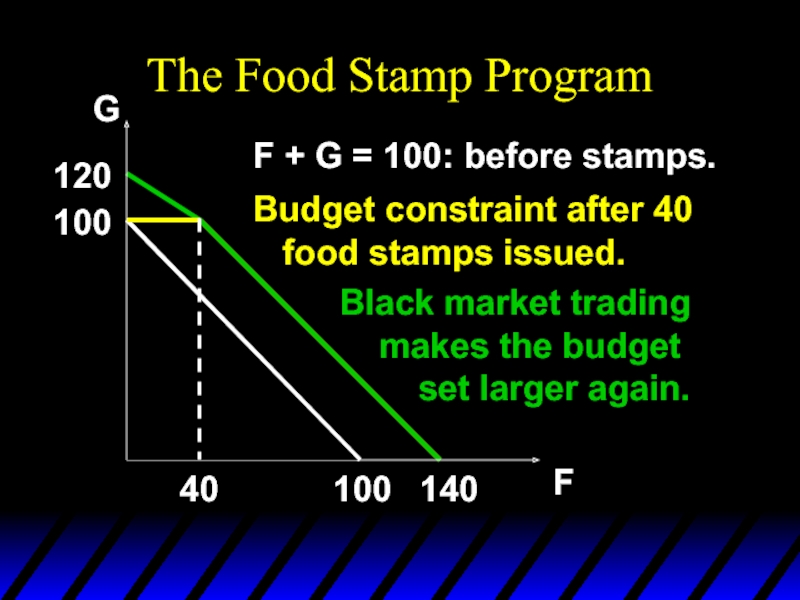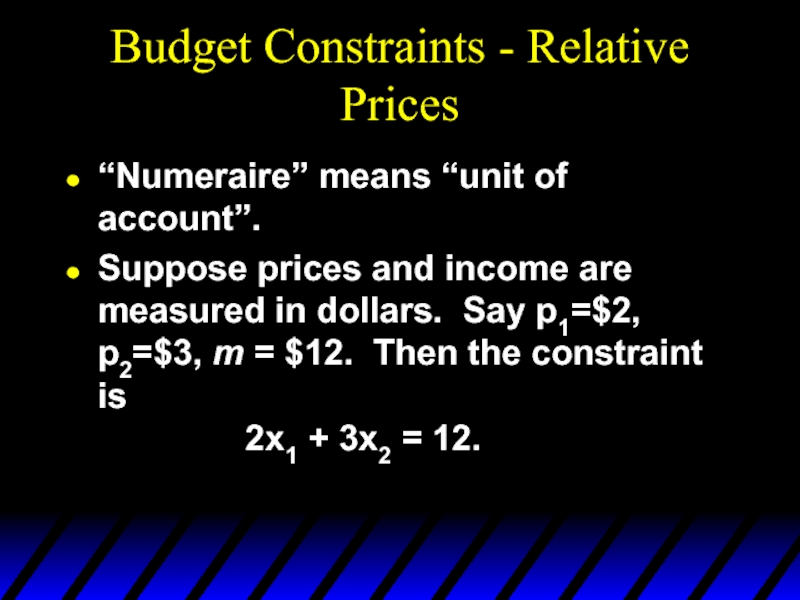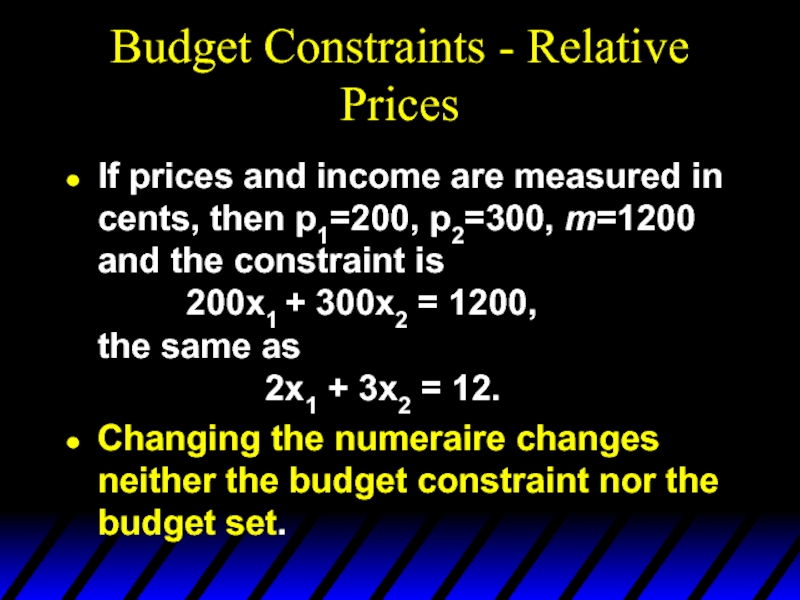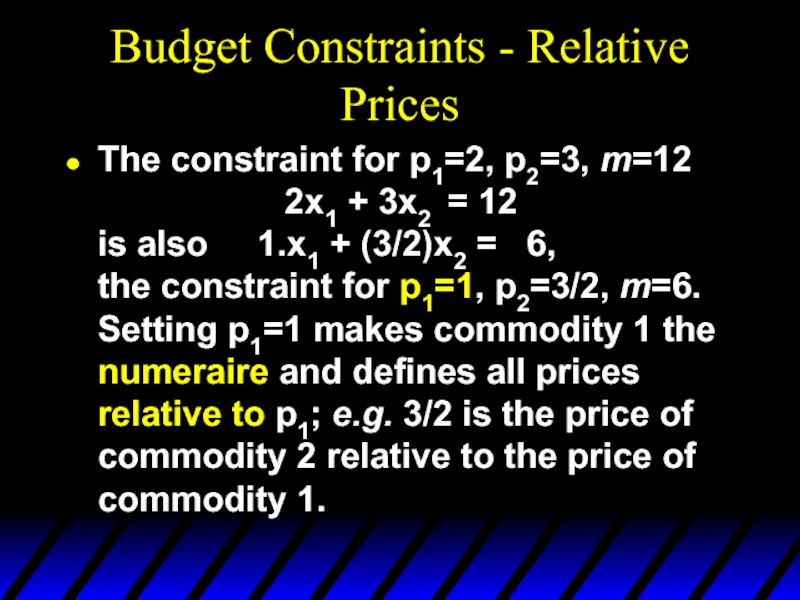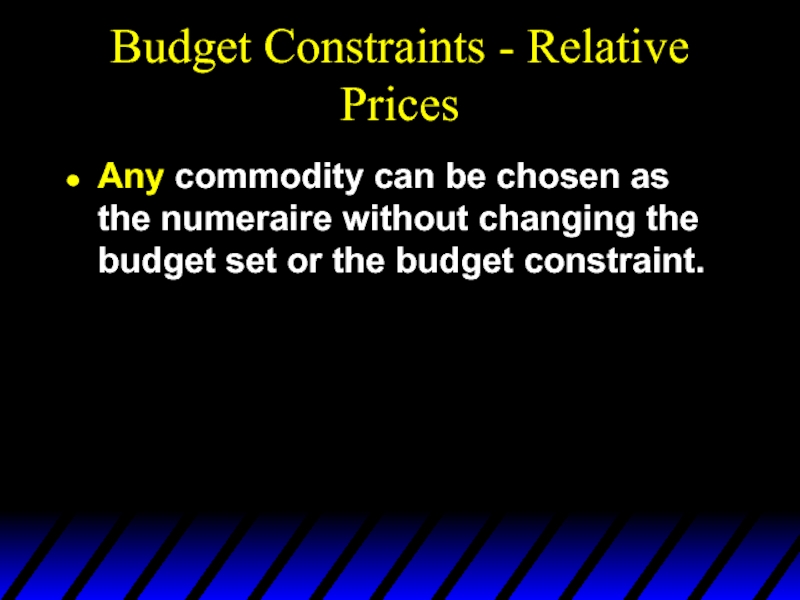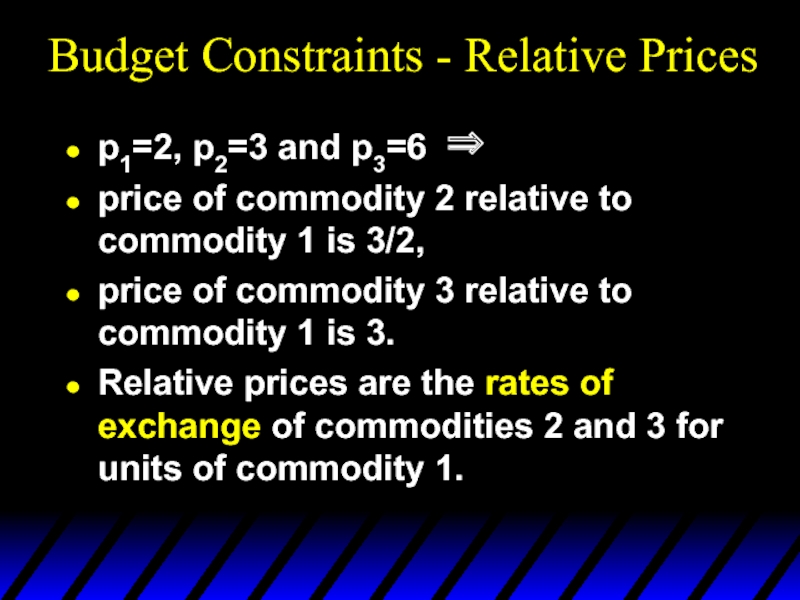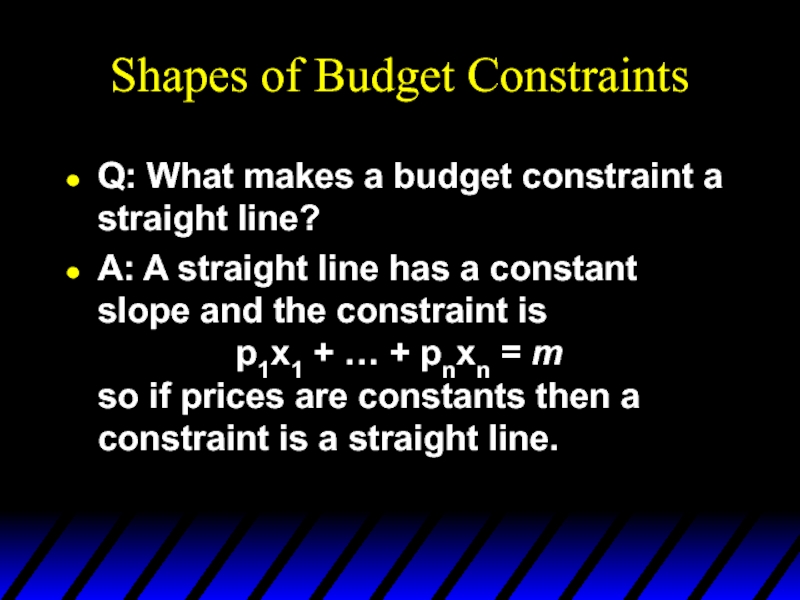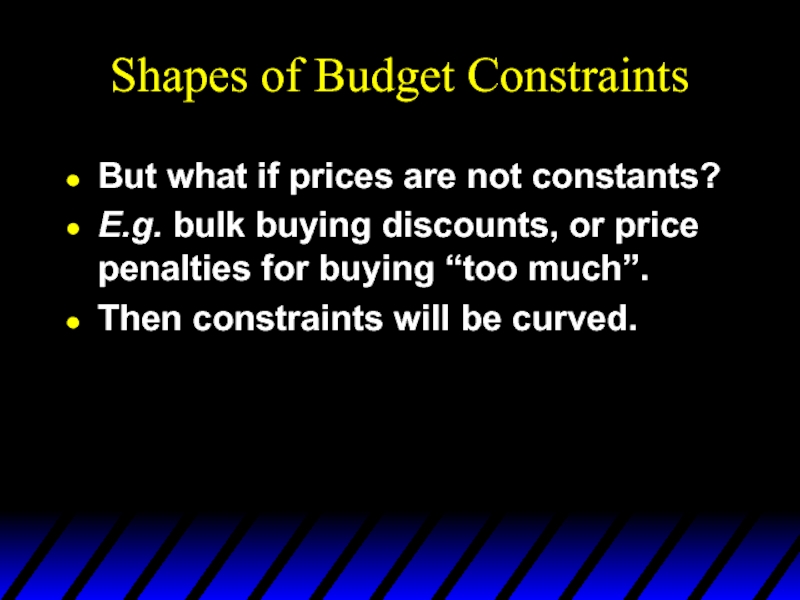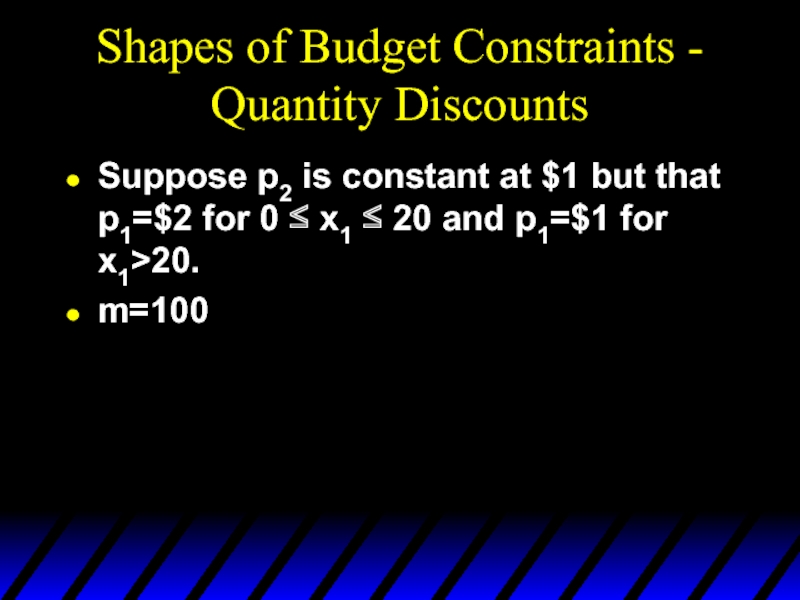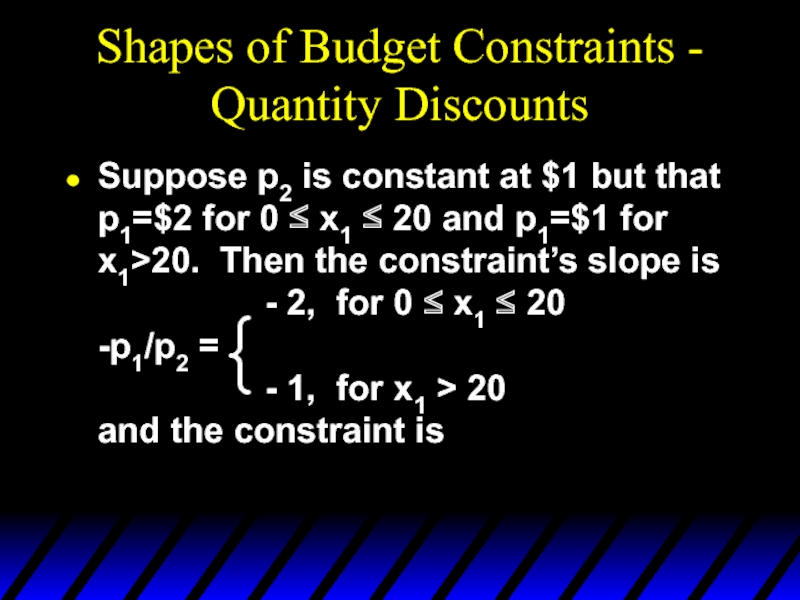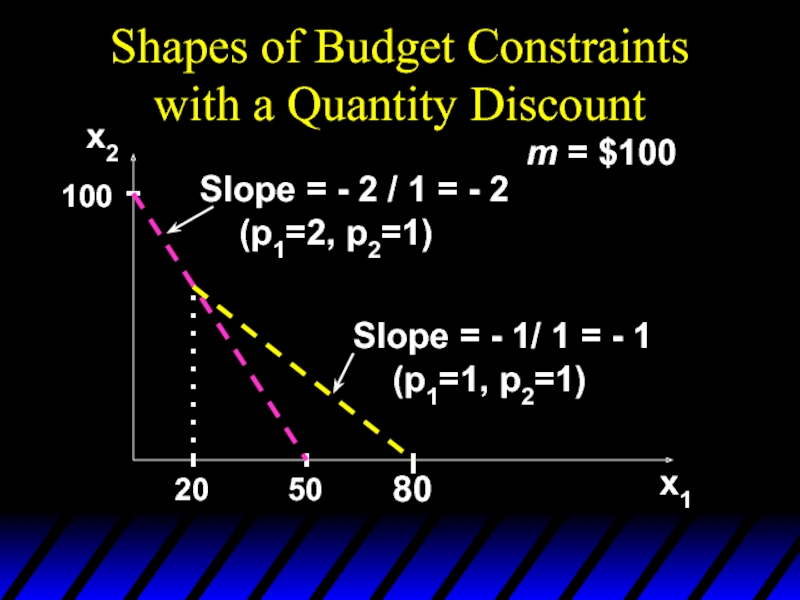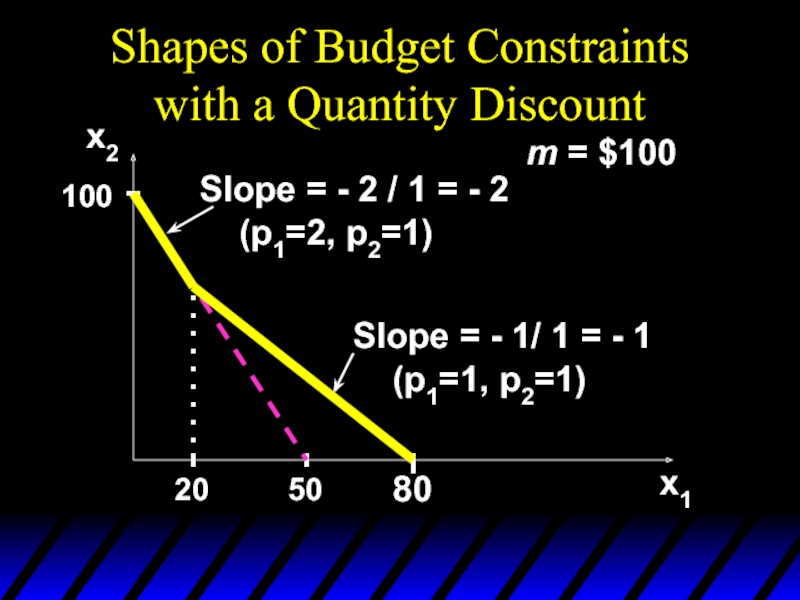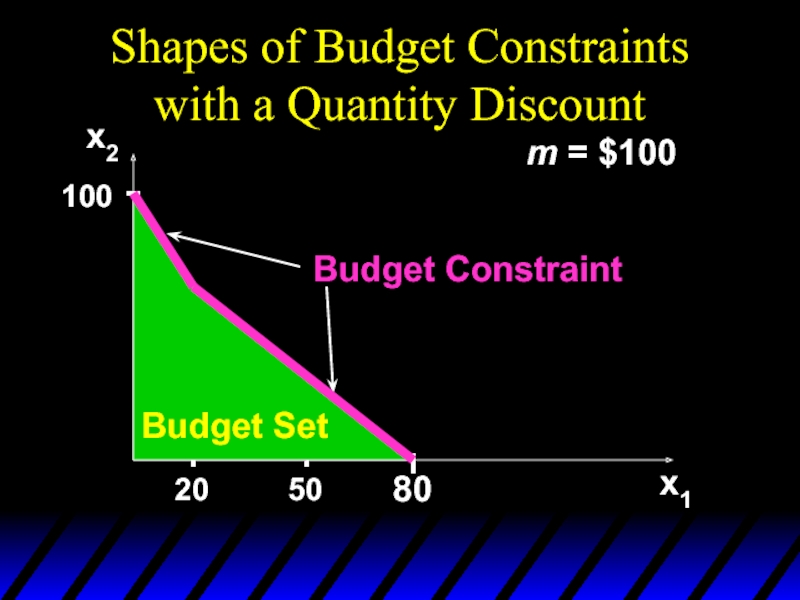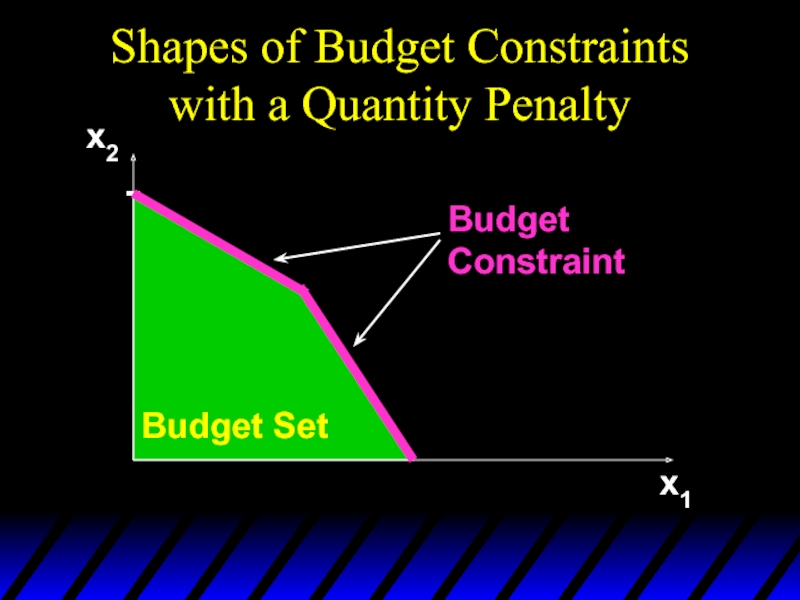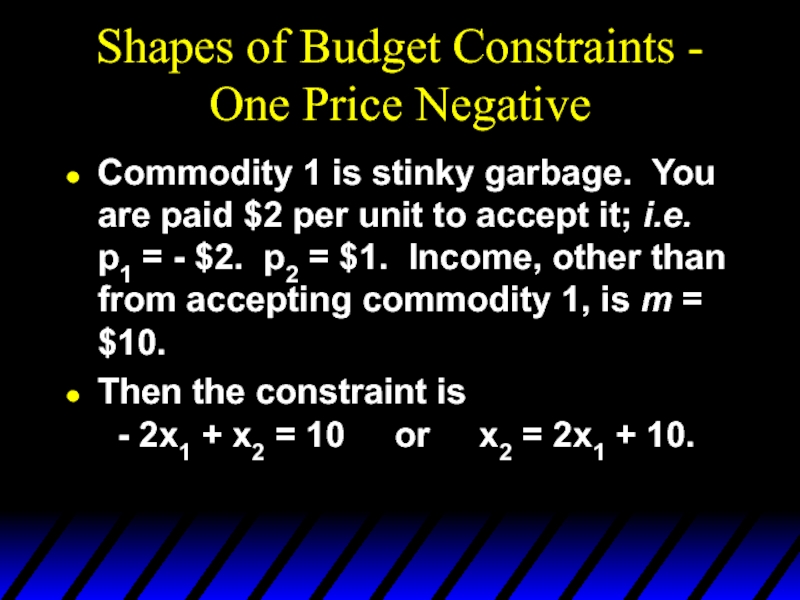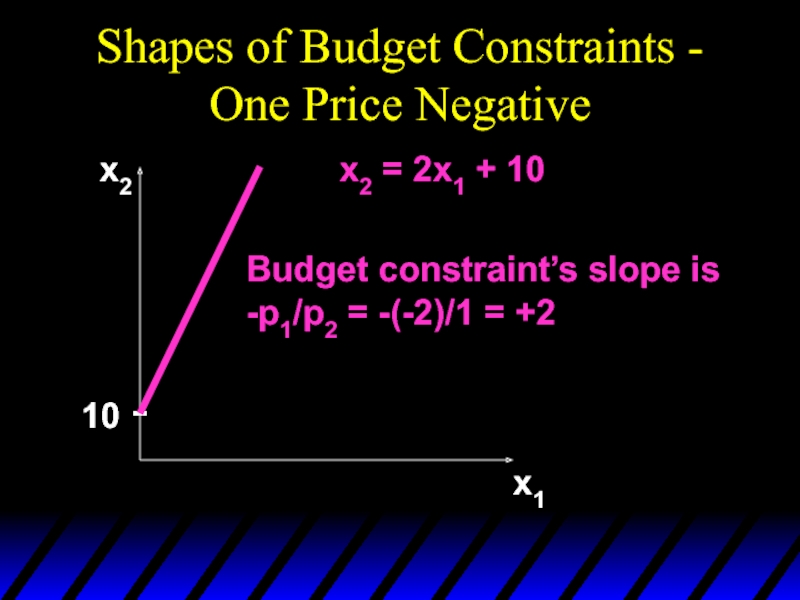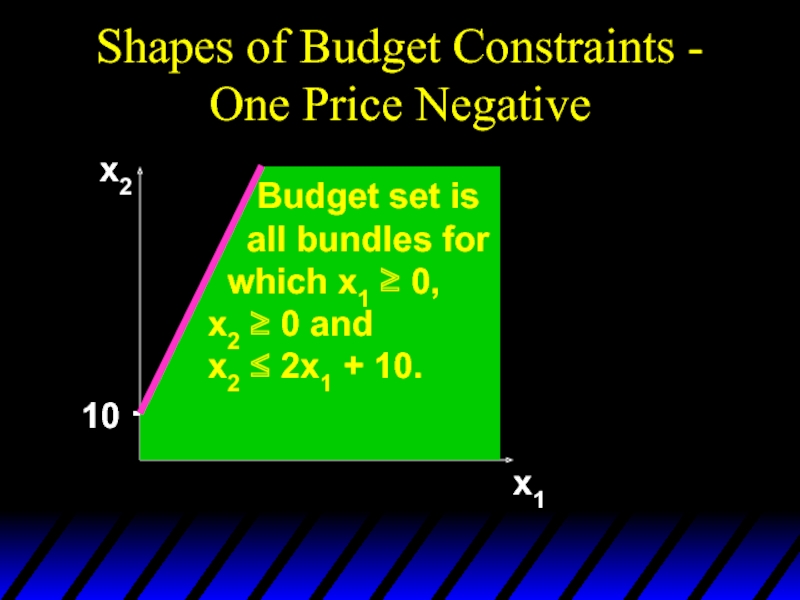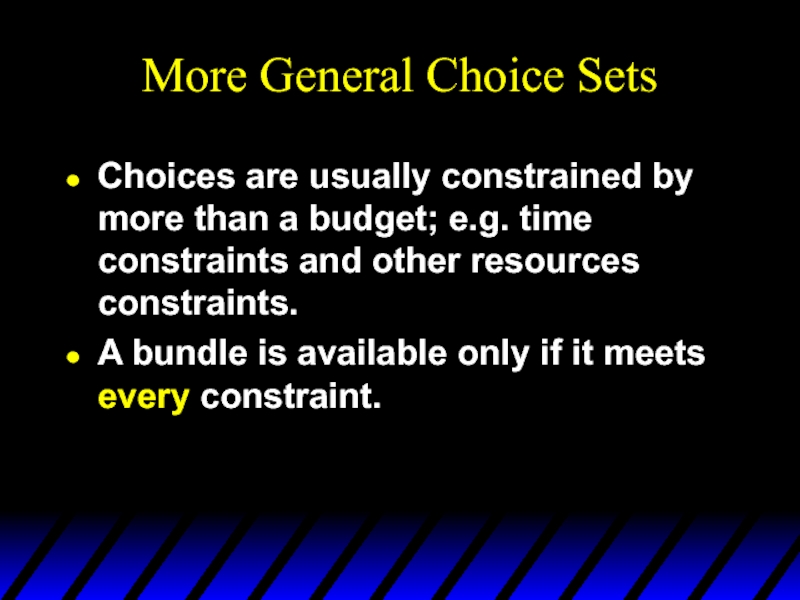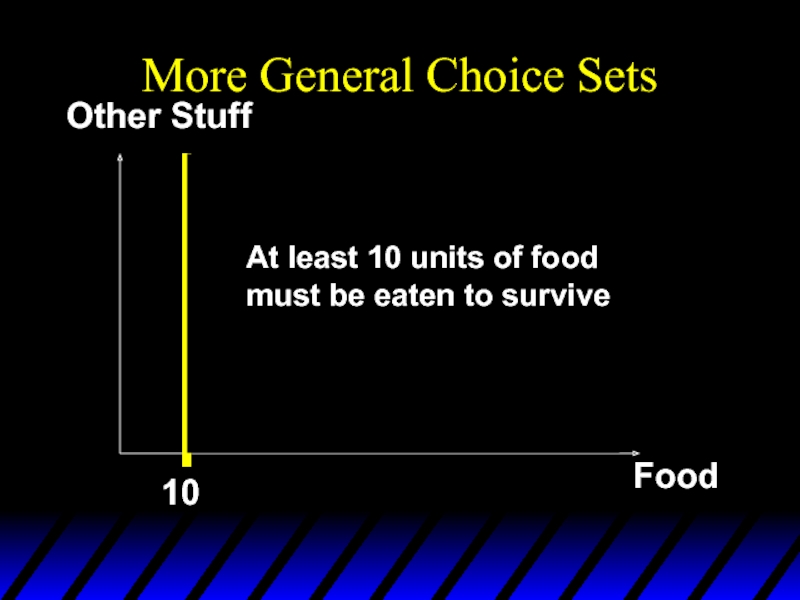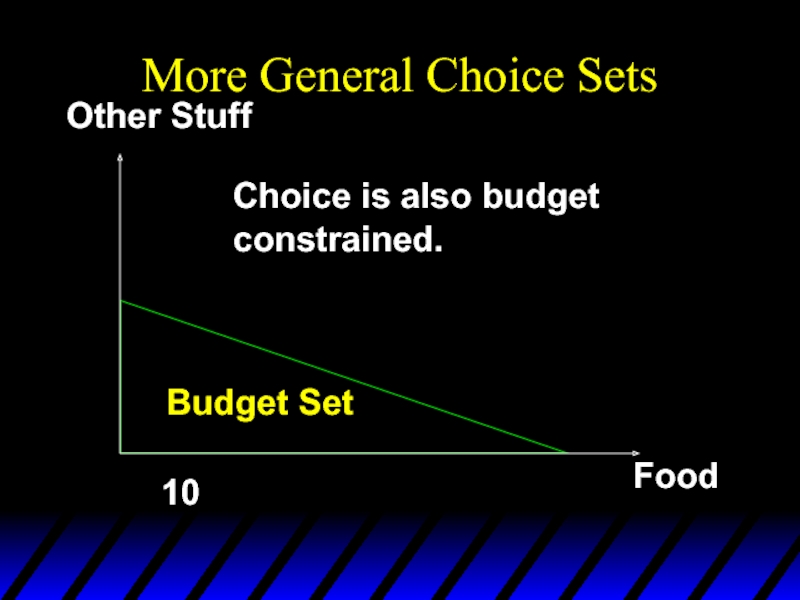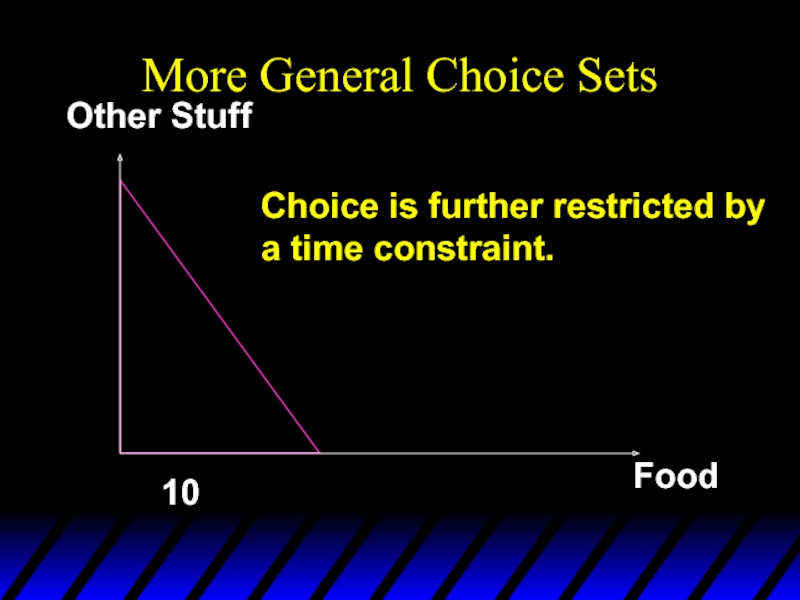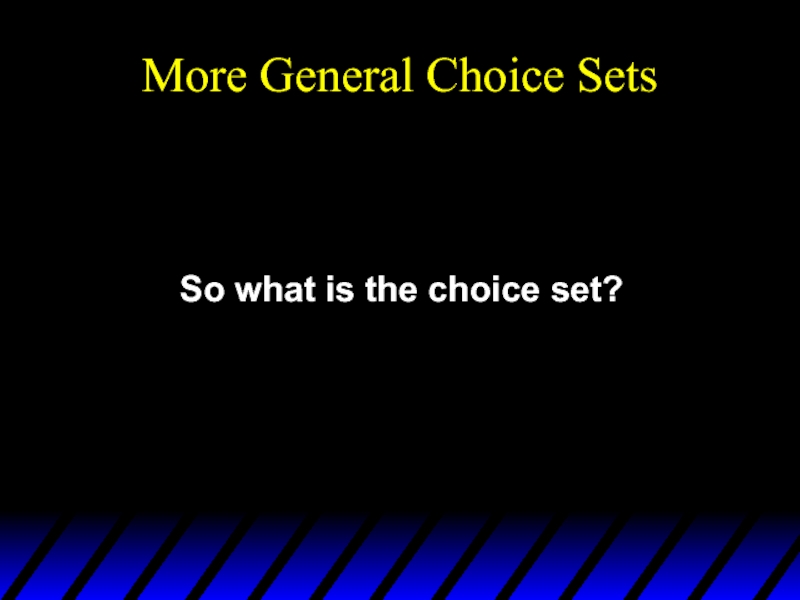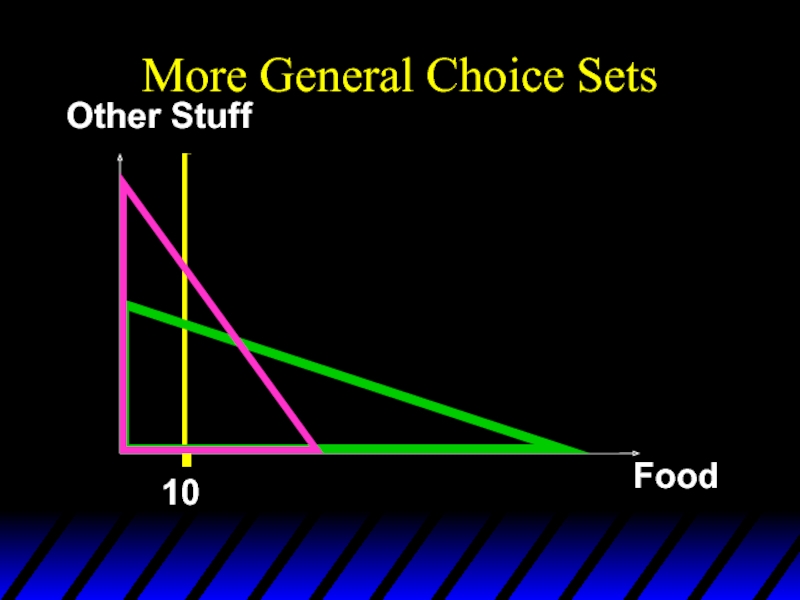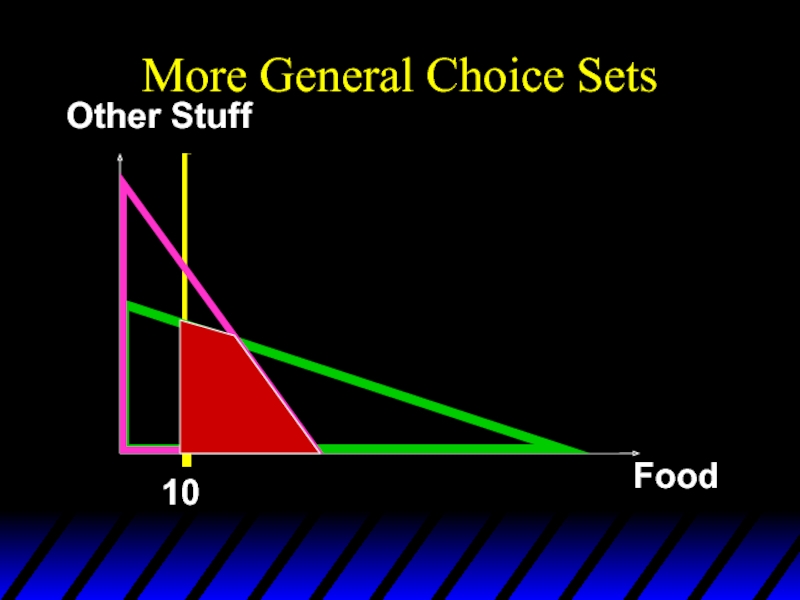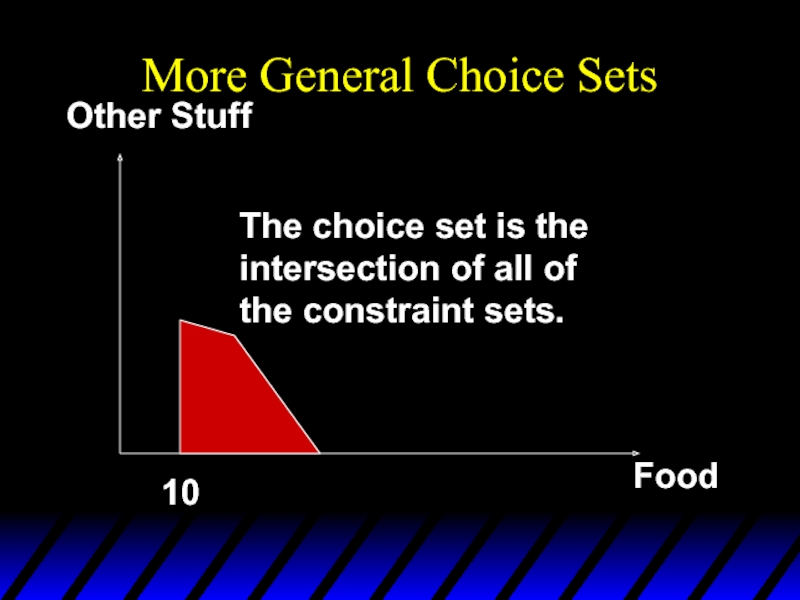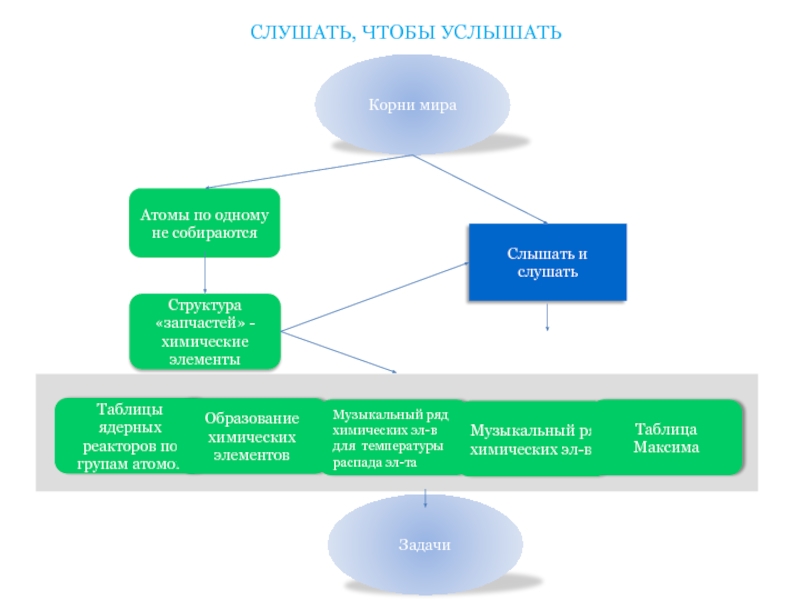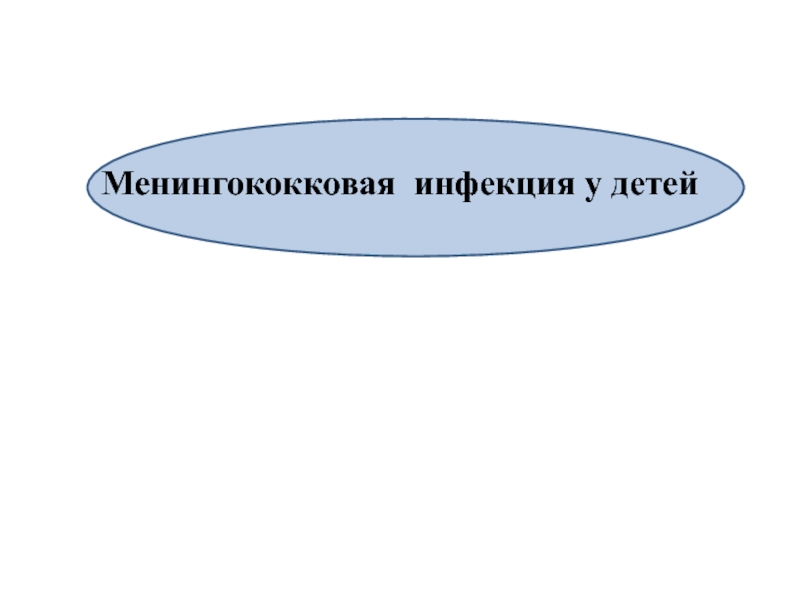Разделы презентаций
- Разное
- Английский язык
- Астрономия
- Алгебра
- Биология
- География
- Геометрия
- Детские презентации
- Информатика
- История
- Литература
- Математика
- Медицина
- Менеджмент
- Музыка
- МХК
- Немецкий язык
- ОБЖ
- Обществознание
- Окружающий мир
- Педагогика
- Русский язык
- Технология
- Физика
- Философия
- Химия
- Шаблоны, картинки для презентаций
- Экология
- Экономика
- Юриспруденция
Chapter Two
Содержание
- 1. Chapter Two
- 2. Consumption Choice SetsA consumption choice set is
- 3. Budget ConstraintsA consumption bundle containing x1 units
- 4. Budget ConstraintsQ: When is a consumption bundle
- 5. Budget ConstraintsQ: When is a bundle (x1,
- 6. Budget ConstraintsThe bundles that are only just
- 7. Budget ConstraintsThe consumer’s budget set is the
- 8. Budget Set and Constraint for Two Commoditiesx2x1Budget constraint isp1x1 + p2x2 = m. m /p1m /p2
- 9. Budget Set and Constraint for Two Commoditiesx2x1Budget constraint isp1x1 + p2x2 = m.m /p2m /p1
- 10. Budget Set and Constraint for Two Commoditiesx2x1Budget constraint isp1x1 + p2x2 = m.m /p1Just affordablem /p2
- 11. Budget Set and Constraint for Two Commoditiesx2x1Budget
- 12. Budget Set and Constraint for Two Commoditiesx2x1Budget
- 13. Budget Set and Constraint for Two Commoditiesx2x1Budget
- 14. Budget Set and Constraint for Two Commoditiesx2x1p1x1
- 15. Budget ConstraintsIf n = 3 what do the budget constraint and the budget set look like?
- 16. Budget Constraint for Three Commoditiesx2x1x3m /p2m /p1m /p3p1x1 + p2x2 + p3x3 = m
- 17. Budget Set for Three Commoditiesx2x1x3m /p2m /p1m
- 18. Budget ConstraintsFor n = 2 and x1
- 19. Budget ConstraintsFor n = 2 and x1
- 20. Budget Constraintsx2x1Slope is -p1/p2+1-p1/p2
- 21. Budget Constraintsx2x1+1-p1/p2Opp. cost of an extra unit
- 22. Budget Constraintsx2x1Opp. cost of an extra unit
- 23. Budget Sets & Constraints; Income and Price
- 24. How do the budget set and budget constraint change as income m increases?Originalbudget setx2x1
- 25. Higher income gives more choiceOriginalbudget setNew affordable consumption choicesx2x1Original andnew budgetconstraints areparallel (sameslope).
- 26. How do the budget set and budget constraint change as income m decreases?Originalbudget setx2x1
- 27. How do the budget set and budget
- 28. Budget Constraints - Income ChangesIncreases in income
- 29. Budget Constraints - Income ChangesIncreases in income
- 30. Budget Constraints - Income ChangesNo original choice
- 31. Budget Constraints - Price ChangesWhat happens if just one price decreases?Suppose p1 decreases.
- 32. How do the budget set and budget
- 33. How do the budget set and budget
- 34. How do the budget set and budget
- 35. Budget Constraints - Price ChangesReducing the price
- 36. Budget Constraints - Price ChangesSimilarly, increasing one
- 37. Uniform Ad Valorem Sales TaxesAn ad valorem
- 38. Uniform Ad Valorem Sales TaxesA uniform sales
- 39. Uniform Ad Valorem Sales TaxesA uniform sales
- 40. Uniform Ad Valorem Sales Taxesx2x1p1x1 + p2x2 = m
- 41. Uniform Ad Valorem Sales Taxesx2x1p1x1 + p2x2 = mp1x1 + p2x2 = m/(1+t)
- 42. Uniform Ad Valorem Sales Taxesx2x1Equivalent income loss is
- 43. Uniform Ad Valorem Sales Taxesx2x1A uniform ad
- 44. The Food Stamp ProgramFood stamps are coupons
- 45. The Food Stamp ProgramSuppose m = $100,
- 46. The Food Stamp ProgramGF100100F + G = 100; before stamps.
- 47. The Food Stamp ProgramGF100100F + G = 100: before stamps.
- 48. The Food Stamp ProgramGF100100F + G = 100: before stamps.Budget set after 40 food stamps issued.14040
- 49. The Food Stamp ProgramGF100100F + G =
- 50. The Food Stamp ProgramWhat if food stamps
- 51. The Food Stamp ProgramGF100100F + G =
- 52. The Food Stamp ProgramGF100100F + G =
- 53. Budget Constraints - Relative Prices“Numeraire” means “unit
- 54. Budget Constraints - Relative PricesIf prices and
- 55. Budget Constraints - Relative PricesThe constraint for
- 56. Budget Constraints - Relative PricesAny commodity can
- 57. Budget Constraints - Relative Pricesp1=2, p2=3 and
- 58. Shapes of Budget ConstraintsQ: What makes a
- 59. Shapes of Budget ConstraintsBut what if prices
- 60. Shapes of Budget Constraints - Quantity DiscountsSuppose
- 61. Shapes of Budget Constraints - Quantity DiscountsSuppose
- 62. Shapes of Budget Constraints with a Quantity
- 63. Shapes of Budget Constraints with a Quantity
- 64. Shapes of Budget Constraints with a Quantity Discountm = $100501002080x2x1Budget SetBudget Constraint
- 65. Shapes of Budget Constraints with a Quantity Penaltyx2x1Budget SetBudget Constraint
- 66. Shapes of Budget Constraints - One Price
- 67. Shapes of Budget Constraints - One Price
- 68. Shapes of Budget Constraints - One Price
- 69. More General Choice SetsChoices are usually constrained
- 70. More General Choice SetsFoodOther Stuff10At least 10 units of foodmust be eaten to survive
- 71. More General Choice SetsFoodOther Stuff10Budget SetChoice is also budget constrained.
- 72. More General Choice SetsFoodOther Stuff10Choice is further restricted by a time constraint.
- 73. More General Choice SetsSo what is the choice set?
- 74. More General Choice SetsFoodOther Stuff10
- 75. More General Choice SetsFoodOther Stuff10
- 76. More General Choice SetsFoodOther Stuff10The choice set is theintersection of all ofthe constraint sets.
- 77. Скачать презентанцию
Слайды и текст этой презентации
Слайд 2Consumption Choice Sets
A consumption choice set is the collection of
all consumption choices available to the consumer.
time and other resource limitations.Слайд 3Budget Constraints
A consumption bundle containing x1 units of commodity 1,
x2 units of commodity 2 and so on up to
xn units of commodity n is denoted by the vector (x1, x2, … , xn).Commodity prices are p1, p2, … , pn.
Слайд 4Budget Constraints
Q: When is a consumption bundle
(x1, … ,
xn) affordable at given prices p1, … , pn?
Слайд 5Budget Constraints
Q: When is a bundle (x1, … , xn)
affordable at prices p1, … , pn?
A: When
p1x1 + … + pnxn £ m
where m is the consumer’s (disposable) income.Слайд 6Budget Constraints
The bundles that are only just affordable form the
consumer’s budget constraint. This is the set { (x1,…,xn) | x1
³ 0, …, xn ³ 0 and p1x1 + … + pnxn = m }.Слайд 7Budget Constraints
The consumer’s budget set is the set of all
affordable bundles; B(p1, … , pn, m) = { (x1, … ,
xn) | x1 ³ 0, … , xn ³ 0 and p1x1 + … + pnxn £ m }The budget constraint is the upper boundary of the budget set.
Слайд 8Budget Set and Constraint for Two Commodities
x2
x1
Budget constraint is
p1x1 +
p2x2 = m.
m /p1
m /p2
Слайд 9Budget Set and Constraint for Two Commodities
x2
x1
Budget constraint is
p1x1 +
p2x2 = m.
m /p2
m /p1
Слайд 10Budget Set and Constraint for Two Commodities
x2
x1
Budget constraint is
p1x1 +
p2x2 = m.
m /p1
Just affordable
m /p2
Слайд 11Budget Set and Constraint for Two Commodities
x2
x1
Budget constraint is
p1x1 +
p2x2 = m.
m /p1
Just affordable
Not affordable
m /p2
Слайд 12Budget Set and Constraint for Two Commodities
x2
x1
Budget constraint is
p1x1 +
p2x2 = m.
m /p1
Affordable
Just affordable
Not affordable
m /p2
Слайд 13Budget Set and Constraint for Two Commodities
x2
x1
Budget constraint is
p1x1 +
p2x2 = m.
m /p1
Budget
Set
the collection
of all
affordable bundles.m /p2
Слайд 14Budget Set and Constraint for Two Commodities
x2
x1
p1x1 + p2x2 =
m is
x2 = -(p1/p2)x1 + m/p2
so slope is -p1/p2.m /p1
Budget
Set
m /p2
Слайд 17Budget Set for Three Commodities
x2
x1
x3
m /p2
m /p1
m /p3
{ (x1,x2,x3) |
x1 ³ 0, x2 ³ 0, x3 ³ 0 and
p1x1 + p2x2 + p3x3 £ m}
Слайд 18Budget Constraints
For n = 2 and x1 on the horizontal
axis, the constraint’s slope is -p1/p2. What does it mean?
Слайд 19Budget Constraints
For n = 2 and x1 on the horizontal
axis, the constraint’s slope is -p1/p2. What does it mean?
Increasing
x1 by 1 must reduce x2 by p1/p2.Слайд 21Budget Constraints
x2
x1
+1
-p1/p2
Opp. cost of an extra unit of
commodity
1 is p1/p2 units foregone of
commodity 2.Слайд 22Budget Constraints
x2
x1
Opp. cost of an extra unit of
commodity
1 is p1/p2 units foregone of
commodity 2. And the opp. cost of an extra unit of commodity 2 is p2/p1 units foregone of commodity 1.-p2/p1
+1
Слайд 23Budget Sets & Constraints; Income and Price Changes
The budget constraint
and budget set depend upon prices and income. What happens
as prices or income change?Слайд 24How do the budget set and budget constraint change as
income m increases?
Original
budget set
x2
x1
Слайд 25Higher income gives more choice
Original
budget set
New affordable consumption
choices
x2
x1
Original and
new budget
constraints
are
parallel (same
slope).
Слайд 26How do the budget set and budget constraint change as
income m decreases?
Original
budget set
x2
x1
Слайд 27How do the budget set and budget constraint change as
income m decreases?
x2
x1
New, smaller
budget set
Consumption bundles
that are no longer
affordable.
Old and
newconstraints
are parallel.
Слайд 28Budget Constraints - Income Changes
Increases in income m shift the
constraint outward in a parallel manner, thereby enlarging the budget
set and improving choice.Слайд 29Budget Constraints - Income Changes
Increases in income m shift the
constraint outward in a parallel manner, thereby enlarging the budget
set and improving choice.Decreases in income m shift the constraint inward in a parallel manner, thereby shrinking the budget set and reducing choice.
Слайд 30Budget Constraints - Income Changes
No original choice is lost and
new choices are added when income increases, so higher income
cannot make a consumer worse off.An income decrease may (typically will) make the consumer worse off.
Слайд 31Budget Constraints - Price Changes
What happens if just one price
decreases?
Suppose p1 decreases.
Слайд 32How do the budget set and budget constraint change as
p1 decreases from p1’ to p1”?
Original
budget set
x2
x1
m/p2
m/p1’
m/p1”
-p1’/p2
Слайд 33How do the budget set and budget constraint change as
p1 decreases from p1’ to p1”?
Original
budget set
x2
x1
m/p2
m/p1’
m/p1”
New affordable choices
-p1’/p2
Слайд 34How do the budget set and budget constraint change as
p1 decreases from p1’ to p1”?
Original
budget set
x2
x1
m/p2
m/p1’
m/p1”
New affordable choices
Budget constraint
pivots; slope flattensfrom -p1’/p2 to
-p1”/p2
-p1’/p2
-p1”/p2
Слайд 35Budget Constraints - Price Changes
Reducing the price of one commodity
pivots the constraint outward. No old choice is lost and
new choices are added, so reducing one price cannot make the consumer worse off.Слайд 36Budget Constraints - Price Changes
Similarly, increasing one price pivots the
constraint inwards, reduces choice and may (typically will) make the
consumer worse off.Слайд 37Uniform Ad Valorem Sales Taxes
An ad valorem sales tax levied
at a rate of 5% increases all prices by 5%,
from p to (1+0×05)p = 1×05p.An ad valorem sales tax levied at a rate of t increases all prices by tp from p to (1+t)p.
A uniform sales tax is applied uniformly to all commodities.
Слайд 38Uniform Ad Valorem Sales Taxes
A uniform sales tax levied at
rate t changes the constraint from
p1x1 + p2x2 = m to (1+t)p1x1 + (1+t)p2x2 = mСлайд 39Uniform Ad Valorem Sales Taxes
A uniform sales tax levied at
rate t changes the constraint from
p1x1 + p2x2 = m to (1+t)p1x1 + (1+t)p2x2 = m i.e. p1x1 + p2x2 = m/(1+t).Слайд 43Uniform Ad Valorem Sales Taxes
x2
x1
A uniform ad valorem
sales tax levied
at rate t
is equivalent to an income
tax levied at rate
Слайд 44The Food Stamp Program
Food stamps are coupons that can be
legally exchanged only for food.
How does a commodity-specific gift such
as a food stamp alter a family’s budget constraint?Слайд 45The Food Stamp Program
Suppose m = $100, pF = $1
and the price of “other goods” is pG = $1.
The
budget constraint is then
F + G =100.Слайд 48The Food Stamp Program
G
F
100
100
F + G = 100: before stamps.
Budget
set after 40 food
stamps issued.
140
40
Слайд 49The Food Stamp Program
G
F
100
100
F + G = 100: before stamps.
Budget
set after 40 food
stamps issued.
140
The family’s budget
set is enlarged.
40
Слайд 51The Food Stamp Program
G
F
100
100
F + G = 100: before stamps.
Budget
constraint after 40
food stamps issued.
140
120
Budget constraint with
black market trading.40
Слайд 52The Food Stamp Program
G
F
100
100
F + G = 100: before stamps.
Budget
constraint after 40
food stamps issued.
140
120
Black market trading
makes the budget
set larger again.40
Слайд 53Budget Constraints - Relative Prices
“Numeraire” means “unit of account”.
Suppose prices
and income are measured in dollars. Say p1=$2, p2=$3, m
= $12. Then the constraint is 2x1 + 3x2 = 12.Слайд 54Budget Constraints - Relative Prices
If prices and income are measured
in cents, then p1=200, p2=300, m=1200 and the constraint is
200x1 + 300x2 = 1200, the same as 2x1 + 3x2 = 12.Changing the numeraire changes neither the budget constraint nor the budget set.
Слайд 55Budget Constraints - Relative Prices
The constraint for p1=2, p2=3, m=12
2x1
+ 3x2 = 12 is also 1.x1 + (3/2)x2 = 6, the constraint for p1=1, p2=3/2, m=6. Setting p1=1 makes commodity 1 the numeraire and defines all prices relative to p1; e.g. 3/2 is the price of commodity 2 relative to the price of commodity 1.Слайд 56Budget Constraints - Relative Prices
Any commodity can be chosen as
the numeraire without changing the budget set or the budget
constraint.Слайд 57Budget Constraints - Relative Prices
p1=2, p2=3 and p3=6
price of
commodity 2 relative to commodity 1 is 3/2,
price of commodity
3 relative to commodity 1 is 3.Relative prices are the rates of exchange of commodities 2 and 3 for units of commodity 1.
Слайд 58Shapes of Budget Constraints
Q: What makes a budget constraint a
straight line?
A: A straight line has a constant slope and
the constraint is
p1x1 + … + pnxn = m
so if prices are constants then a constraint is a straight line.Слайд 59Shapes of Budget Constraints
But what if prices are not constants?
E.g.
bulk buying discounts, or price penalties for buying “too much”.
Then
constraints will be curved.Слайд 60Shapes of Budget Constraints - Quantity Discounts
Suppose p2 is constant
at $1 but that p1=$2 for 0 £ x1 £
20 and p1=$1 for x1>20.m=100
Слайд 61Shapes of Budget Constraints - Quantity Discounts
Suppose p2 is constant
at $1 but that p1=$2 for 0 £ x1 £
20 and p1=$1 for x1>20. Then the constraint’s slope is - 2, for 0 £ x1 £ 20 -p1/p2 = - 1, for x1 > 20 and the constraint is{
Слайд 62Shapes of Budget Constraints with a Quantity Discount
m = $100
50
100
20
Slope
= - 2 / 1 = - 2 (p1=2,
p2=1)Slope = - 1/ 1 = - 1
(p1=1, p2=1)
80
x2
x1
Слайд 63Shapes of Budget Constraints with a Quantity Discount
m = $100
50
100
20
Slope
= - 2 / 1 = - 2 (p1=2,
p2=1)Slope = - 1/ 1 = - 1
(p1=1, p2=1)
80
x2
x1
Слайд 64Shapes of Budget Constraints with a Quantity Discount
m = $100
50
100
20
80
x2
x1
Budget
Set
Budget Constraint
Слайд 66Shapes of Budget Constraints - One Price Negative
Commodity 1 is
stinky garbage. You are paid $2 per unit to accept
it; i.e. p1 = - $2. p2 = $1. Income, other than from accepting commodity 1, is m = $10.Then the constraint is - 2x1 + x2 = 10 or x2 = 2x1 + 10.
Слайд 67Shapes of Budget Constraints - One Price Negative
10
Budget constraint’s slope
is
-p1/p2 = -(-2)/1 = +2
x2
x1
x2 = 2x1 + 10
Слайд 68Shapes of Budget Constraints - One Price Negative
10
x2
x1
Budget set is all bundles for which x1 ³
0, x2 ³ 0 andx2 £ 2x1 + 10.
